The manager explains how his fund’s process has evolved since 2019 and why value signals dominated its positioning this year.
Fundamental analysis is not sufficient for navigating today’s equity markets, as sentiment has become a far stronger force in driving returns. This is the view of FE fundinfo Alpha Manager Amadeo Alentorn, who runs the Jupiter Merian Global Equity fund.
His team’s stock-picking model blends intuitive insights, data modelling and behavioural signals to identify which investing styles are most likely to work at any point in the cycle.
Below, Alentorn explains how the experience of 2019 led him to give sentiment a greater role within the process, why Jupiter Merian Global Equity has maintained a material overweight to European banks and why he is focused today on avoiding overpayment for quality.
Performance of fund against index and sector over 1yr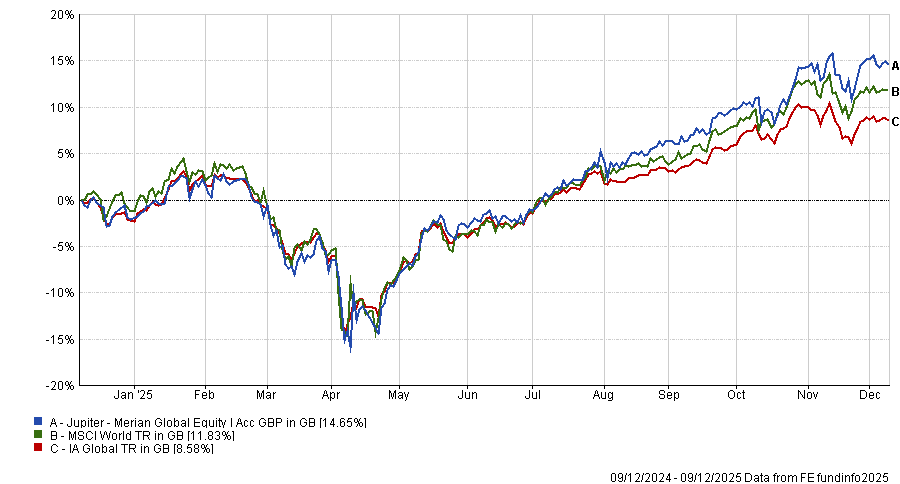
Source: FE Analytics
How does Jupiter Merian Global Equity invest?
To be a successful stock picker you need to use different investing styles at different moments, because research suggests that there is no single style that's going to be successful across an entire market cycle. This is the core of our philosophy.
The fund follows a style-agnostic, systematic process to allow us to dynamically shift into the styles that are going to be more prominent. This is done by capturing the market environment and learning through history what has worked well in similar historic environments.
We use data modelling and intuitive insights to drive stock picking.
What do you mean by ‘intuitive insights’?
Some funds use artificial intelligence or machine learning to identify and exploit patterns in markets. We instead go through five stock-selection criteria and three of them are based around intuitive, fundamental ideas: valuation, growth and the quality of the management team. We measure these systematically without our personal opinions coming into play but then we go beyond fundamentals.
To be a successful stock picker, fundamental analysis is not enough, especially when you go through very sentiment-driven markets like the ones we've been seeing in recent years. So we incorporate metrics of sentiment that help us to understand where the buying and selling pressures are across the equity market, as well as price-driven signals, recognising that trends and reversals can also be very powerful forces in markets. This is one of our key differentiators.
How do you measure sentiment and what’s your reading of the market today?
You can think of our models as a thermometer that’s taking the market’s temperature across those two dimensions, optimism and uncertainty. Then, it travels back through time 40 years to identify environments where there was a similar investor behaviour.
This year, particularly in the summer, the model has correctly identified a high-optimism, risk-on sentiment where historically, investing in expensive, high-quality names didn’t typically work. Instead, it’s more profitable to focus on stocks that are attractively valued, even if their balance sheet is not the highest in the universe.
We’re still considering balance sheet strength, but crucially, not overpaying for quality. This has been one of the key drivers of performance this year.
How did this information shape your allocation this year?
Today, the valuation component represents approximately 15% of the model, whereas the balance-sheet quality signals represent about 3%. So we have five times more emphasis to valuation as opposed to higher quality names.
The model recalculates daily and we are allowing the fund to trade for less than 1% turnover per day. We are very careful with transaction costs, so we need to ensure that when we are trading in and out of stocks, the expected payoff of those trades is profitable.
At the end of a year this fund has typically a two-times turnover, so it’s like having two complete different portfolios every year through this very gradual process of trading.
In which environments does this strategy work less well?
2019 is an example of an environment that was more difficult for us than many fundamental managers, as markets, especially in the US, were going through an abnormal and profitable tech bubble.
Loss-making, poorly run but expensive companies with very large growth potential were very rallying very strongly and markets were chasing that growth. For our philosophy it is more difficult to make sense of periods like that, when people are disregarding fundamentals.
Since then, we have made a number of improvements to our systematic process to expand the role of sentiment and capture more sentiment-driven signals. This has helped us to better navigate the last two to three years very successfully, as there are parallels today to what happened in 2019.
What were your best calls of the past year?
Banks, and in particular European banks, have been a great example of applying our data-driven, style-agnostic process to identify stocks with a nice alignment of signals.
European banks have been an overweight of as much as 4% at points, and it was particularly accretive – better than tech, which added 10 basis points to our performance.
However the more positive sector relative to the benchmark has been consumer staples, which added 20 basis points to performance.
And the worst?
Our healthcare positioning has been slightly negative in terms of contribution – it’s one of the very few dimensions that hasn’t worked out so well. We started the year being underweight healthcare, which did very well as a sector at the end of the year. That resulted in us losing 10 basis points.
As part of its dynamism, the fund readjusted and the relative allocation went from -2% to 2%, a 4% swing. The position has now started to work more positively.
What do you do when you’re not working?
I'm quite sporty – I run and play tennis. To relax, I play acoustic guitar.
It’s that time of year again, when investors ask the same question: what happens next? So fund managers dust off their crystal balls.
Forecasting is a mug’s game when markets have a habit of wrong-footing even the most seasoned strategists. Yet as December rolls around, everyone wants to know what the coming 12 months might bring.
That doesn’t mean all fund managers’ annual outlooks should be overlooked or written off as marketing fluff. I particularly enjoyed Man Group’s this year, where chief market strategist Kristina Hooper presents three distinctly different scenarios for how 2026 could unfold.
The range between them shows the reality facing investors today: enormous uncertainty with dramatically different outcomes, each demanding fundamentally different positioning. (Full disclosure: I lean bearish. More on that later.)
Base case: Mild US recession, tepid global growth
Man Group’s central scenario anticipates a shallow US recession as tariffs disrupt trade flows, immigration restrictions tighten labour markets and unemployment creeps higher. The Federal Reserve eases modestly, but inflation remains sticky enough to limit how far rates can fall.
Meanwhile, the firm sees the rest of the developed world taking a different path. Europe and Japan accelerate on the back of substantial fiscal stimulus, particularly defence spending as geopolitical tensions reshape budget priorities. China sees stable-to-slightly-lower growth as fiscal measures offset persistent property sector weakness. The UK muddles through with flat-to-modest growth, helped by an accommodative Bank of England. Emerging Asia benefits from a weaker dollar and favourable regional dynamics.
This is a world of divergence, where monetary policy fragments, growth patterns split and the old correlations break down.
If this scenario plays out, how to position is straightforward: look outside the US.
Man Group favours developed market equities excluding the US, especially the eurozone and Japan, where fiscal stimulus should generate momentum and valuations remain attractive. UK equities also merit attention given low valuations, high dividend yields and the potential for positive earnings surprises if the Bank of England eases more than expected.
Chinese tech stocks could present an interesting opportunity. They trade at lower valuations than their US counterparts while benefiting from government policy support for strategic industries.
Within styles, Man Group expects quality to outperform. Stocks with strong balance sheets should outperform as concerns about AI-related debt and softer global growth weigh on more leveraged names.
In fixed income, European investment-grade and high-yield debt look appealing given the positive growth backdrop in the eurozone. Man Group sees potential for a gradual yield curve steepening, suggesting shorter-duration positioning makes sense.
Currency markets should favour the Japanese yen and euro over the dollar as the Bank of Japan tightens from its ultra-accommodative stance while the European Central Bank holds steady.
For alternatives, equity market neutral strategies suit an environment prone to both rallies and sell-offs. Diversified multi-strategy portfolios make sense given the uncertainty and potential for market rotations. Selective private credit offers diversification benefits and tends to perform well when volatility is elevated. Precious metals with industrial uses (gold, silver, palladium, platinum) straddle both safe-haven and pro-cyclical characteristics.
Upside scenario: Capex supercycle and détente
In Man Group’s upside scenario, the opposite happens. Trade wars end, and artificial intelligence capital expenditure not only continues but accelerates. Emerging markets, including China and India, see growth pick up meaningfully. The eurozone and Japan get a GDP lift. The US experiences modest growth as the Fed eases.
In this world, where markets go full risk-on, emerging Asia takes centre stage. Indian and domestic Chinese stocks look attractive. Chinese tech and US tech stocks both perform strongly. European cyclicals are well-positioned to benefit. Global small-caps and mid-caps outperform as risk appetite returns.
Cyclical sectors shine. Man Group highlighted industrials, materials, energy services, semiconductors and semiconductor capital equipment, shipping and logistics and selective financials as the areas that benefit most when economies expand and confidence returns.
Fixed income shifts towards risk. Global high-yield bonds and emerging-market bonds (preferably hard currency) appeal, as these assets historically perform well in risk-on environments. Emerging market local currency debt becomes interesting if real interest rates rise and credible disinflation takes hold.
Currency markets favour commodity-exposed currencies like the Canadian and Australian dollars, which outperform when demand for industrial commodities picks up during economic expansion.
Alternatives focus on the real economy. Industrial commodities and energy present opportunities as these assets typically see significant price increases when growth accelerates. Trend-following strategies allow investors to participate robustly in a sustained risk-on environment.
Downside scenario: Policy errors and AI capex stall
But there’s also the potential for a bear outcome. In Man Group’s downside scenario, policy mistakes compound, the artificial intelligence capital expenditure boom collapses as companies fail to realise expected returns, and the US enters a deep recession.
The Federal Reserve wants to cut rates but can’t because inflation remains persistently elevated. Even substantial fiscal stimulus in the eurozone, Japan and China only partially cushions the blow. In this environment, markets go risk-off and stay there.
When positioning for this scenario, defence becomes paramount. In equities, Man Group suggests only select large-cap names in defensive sectors: consumer staples and regulated utilities. These are businesses with stable demand regardless of economic conditions.
Fixed income focuses on capital preservation. Inflation-protected securities perform relatively well in a higher-inflation setting, while sovereign debt with high credit ratings offers resilience in the face of a major economic downturn.
Currency markets separate true safe havens from false ones. Man Group holds a preference for the Swiss franc, Japanese yen and euro, but is cautious about the US dollar given some erosion in confidence.
Alternatives emphasise protection. Gold holds up well in a risk-off environment. Trend-following strategies and volatility risk management strategies can provide downside protection.
A Grinch’s Reflection
I should admit my bias: I instinctively lean bearish. I'm a perma-bear Grinch by nature.
In 2025, I positioned accordingly. I sat almost entirely in cash, convinced that the rally couldn’t last as valuations were stretched and risks were underpriced.
I was wrong, obviously. While markets climbed, I watched from the sidelines. Even the Grinch eventually learned that maybe he'd been looking at things wrong all along.
Maybe my New Year's resolution should be to channel a bit more Whoville optimism? The Whos down in Whoville didn’t spend their time worrying about worst-case scenarios.
That doesn’t mean abandoning risk management or ignoring genuine threats. But it might mean staying more open to different outcomes. Diversifying not just portfolios but perspectives. Considering that the bulls might have a point, or at least that the future isn't predetermined to disappoint.
Man Group’s three scenarios serve as a useful reminder. Nobody knows which path 2026 will take. The honest position is to acknowledge the range of possibilities and position flexibly enough to adapt as the year unfolds. Perhaps the real lesson isn’t in picking the right scenario, but in staying humble enough to adjust when the evidence changes.
And for this particular Grinch, that might mean letting a bit more optimism in. After all, sitting in cash all year while everyone else prospered isn't nearly as clever as it felt at the time.
Gary Jackson is head of editorial at FE fundinfo. The views expressed above should not be taken as investment advice.
Investors are encouraged to take profits from their US passive exposure.
Investing in the US market through an index tracker has been a no-brainer for at least a decade, but things have changed, with new questions arising.
As leadership has narrowed in the hands of just seven tech giants and valuations have stretched, investors have been wondering how to approach the index sensibly. Should they take profit after years of extraordinary outperformance? Should they buy more to remain on board the artificial intelligence (AI) train? Or does the more balanced exposure of an equally weighted version of the index serve them better?
We asked experts these questions and the answer was almost unanimous.
Performance of index over the year to date and 10yrs
Source: FE Analytics
Commentators have been forecasting the demise of the US bull market for a long time, but, as the chart above shows, it keeps powering on, led by continued confidence in the AI story.
The main problem with the S&P 500 is the utter dominance of just a handful of stocks. Does it matter what stock number 100, 200 or 500 does, when the top 10 represent 40% of the index, Fairview Investing director Ben Yearsley asked.
“You have to believe the AI story to be fully confident in continuing to hold a market-cap weighted S&P tracker,” he said.
For this reason, he suggested investors take profits and aim for a 50/50 split between an equal-weighted and market-cap weighted tracker. This way, investors still get access to US tech without it dominating their portfolio (incidentally, this is exactly what Bestinvest’s Jason Hollands told Trustnet he is doing with his portfolio).
Yearsley said: “I'm still a believer in the long term of AI and US tech, however you can't get away from the valuation issue. Outside the Magnificent Seven, valuation are much more normal.
“On the flip side, the talk is being turned into sales and cash flow so analogies with the dotcom boom and bust are wide off the mark.”
Rob Morgan, chief analyst at Charles Stanley, said it’s right to be wary about the concentrated, top-heavy nature of the S&P index and to mitigate that through appropriate position sizing, but it “still merits a place at the core of an equity portfolio”.
“While it is difficult to discern the winners from the losers at an individual stock level, constituents of the S&P will continue to be the titans of tomorrow and it makes sense to maintain exposure,” he said.
As part of a diversified portfolio, a US tracker accompanied by an active value-led fund is therefore “a perfectly reasonable compromise”.
Geographically, investors may wish to underweight the US given where valuations are, but 2025 has in fact been a year of significant ‘catch up’ by other areas such as Asia, Europe and Japan – especially for UK investors given weakness in the dollar.
“This broadening out is healthy and proves the benefits of diversification, and it’s something that could continue for a bit longer,” said Morgan.
“Yet many of the cheap areas are no longer as cheap as they were, which does imply that the opportunity to rebalance away from the US as a tactical move has now largely passed.”
The high cost of US equities by historical standards is something “there’s no getting away from”, according to Darius McDermott, managing director at FundCalibre, although valuation alone isn’t a reason to exit completely.
“I thought the same 12 months ago and since then the S&P 500 has risen another 13%,” he said. While he added that nobody should buy just because the US market has gone up, the US does continue to benefit from world-class innovation, deep capital markets and resilient earnings, so “for anyone with a 10 to 20-year time horizon, completely selling out would be a mistake as long-term investors will likely still make money”.
For most investors, selectively trimming makes more sense than selling everything, McDermott said.
“Trim if it has grown too large in the portfolio, but don’t abandon the US altogether,” he said. “The opportunity in AI could still be enormous, even if the journey involves volatility and structurally the US remains one of the best places in the world for long-term equity ownership.”
Locking in some of the gains and reallocating to cheaper, higher-potential areas can “improve future returns without losing the structural exposure the US provides” – for this, he highlighted emerging markets or UK smaller companies.
Alternatively, moving part of the allocation from a passive index into a high-quality active US or global fund, such as Brown Advisory US Flexible Equity or Nutshell Growth, can “help investors capture upside while avoiding the most expensive names”.
Performance of funds against index and sector over the year to date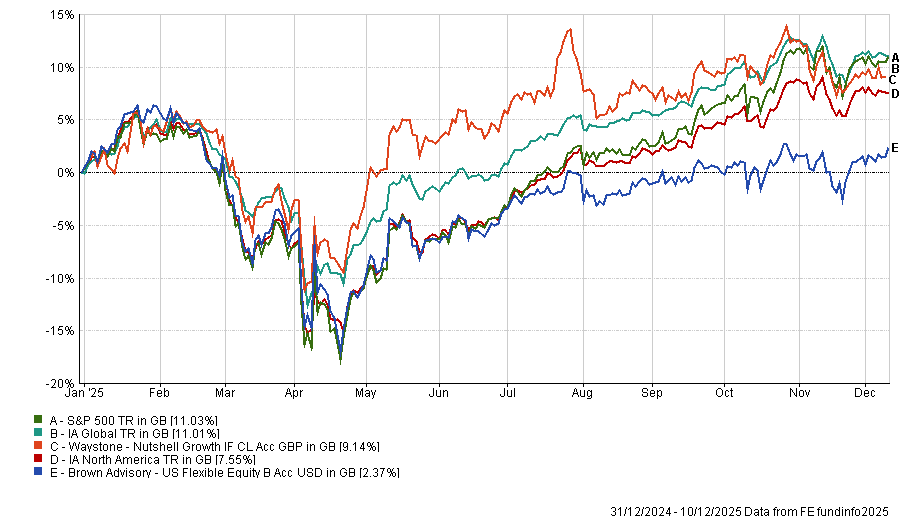
Source: FE Analytics
Evenlode Income manager Hugh Yarrow looks at how today’s markets are making high-quality companies more attractive.
We are at an interesting market juncture for our quality approach. Stuck between AI infrastructure plays on the one hand and banks and commodity stocks on the other, the shares of many asset-light, cash-compounding quality companies have become increasingly unfashionable.
Some have not been helped by post-Covid complications over the last three years (particularly for consumer-facing companies), while 2025’s tariff uncertainty and a weak dollar have further acted as a headwind to sentiment for holdings with US divisions. These drivers have created a confluence of short-term but unfavourable market dynamics for many high-quality names.
However, it has also produced a rare opportunity where investors can get access to high-return, market-leading businesses on an unusually attractive free cash flow yields (for example, the Evenlode Income fund’s cash flow yield currently stands at 5.6% and is forecast to be 6% next year).
Meanwhile, we are seeing fundamental revenue and profit growth continue at a good pace, while cash generation is resilient and long-term prospects look attractive. The shares of these companies also represent stakes in productive assets that sell services and products which their customers place a high value on over time. In other words, these assets should protect long-run investors from inflation and currency depreciation.
Quality (at-a-discount)
Enduring global franchises are particularly interesting. Repeat-purchase consumer brand companies account for around 18% of the portfolio, with Unilever, Diageo and Reckitt the three largest holdings in this category. Despite a challenging consumer environment over the past 18 months, these three holdings remain resilient businesses.
Unilever has faced a mixed backdrop in 2025 but continues to post solid revenue growth. It is outperforming in the US thanks to stepped-up investment levels, whereas conditions are softer in Latin America due to tariff concerns. The company delivered 3.4% organic sales growth in the first half and expects 3-5% growth for the full year, alongside margin expansion. Brand and marketing investment is running at multi-year highs, reflecting management’s focus on strengthening long-term brand equity.
This bodes well for future growth. Following the spin-off of its ice cream division, Unilever is targeting mid-single-digit revenue growth and improving margins. With its portfolio concentrated on 30 ‘power brands’, such as Dove and Vaseline (now over 75% of group sales) the company’s focus on high-growth beauty and personal care categories should underpin resilient cash-generative growth. At a forward PE of 16x and a 3.7% dividend yield, valuation is very appealing – back to levels last seen in the early 2010s.
Mission-critical holdings
The five information services companies held in the fund make up approximately 18% of the portfolio (RELX, Experian, Sage, LSEG and Wolters Kluwer). These are all distinct business models and operate in different verticals, enjoying strong competitive advantages and growing well. Their services are also mission-critical, highly embedded within customer workflows, represent a low proportion of customer’s overall spend and are largely subscription-based in nature – all characteristics that lead to resilient, predictable cash generation.
Having benefited from a positive glow around AI adoption through much of 2023 and into 2024, their share prices have fallen back over the summer, as the stock-market narrative has switched from the opportunities that generative AI and agentic AI are bringing to these businesses, to the possibility of disruption risk. Though not complacent, we think the economic moats of these businesses are wide and deep, and provided they invest properly to embed generative AI and agentic AI into their customers workflows, growth opportunities remain very good as the world continues to digitise.
Walled gardens
RELX is an illustrative example. The company grew organic revenue by 7% and earnings at 10% in the first half of 2025, and management expect growth to accelerate over coming years.
Under the bonnet in its electronic revenue segment there has been a significant shift from digital information to increasingly sophisticated data analytics, with RELX having been a leader in machine-learning and extractive AI for more than 15 years.
For RELX, the recent developments in generative AI and agentic AI are most pertinent for its legal services business, LexisNexis, which represents about 20% of group sales. LexisNexis is the world’s largest legal database, containing over 100 billion documents with millions more added every day.
As with the rest of the RELX group, LexisNexis has pursued a customer-led development strategy with a culture of continuous reinvestment over the years. Its data, and crucially the data analytics services it builds around and on top of this data, have become very embedded in customers workflows as a result. Taken together, we do not think it is realistic for an AI start-up to replicate RELX’s legal moat over the coming years.
Compounding capital
Across the portfolio, we continue to prioritise a diverse collection of high-quality businesses that – like Unilever and RELX – enjoy strong competitive advantages, healthy cash generation, and resilient long-term growth. These are qualities that have been underappreciated in recent months as polarised sector performance and a fear-of-missing-out psychology have prevailed in both UK and global markets. Over time though, thanks to the power of quiet compounding, these companies tend to be great friends to their shareholders.
As capital has increasingly flowed towards momentum and cyclicality, the opportunity in high-quality businesses has rarely been more striking.
Hugh Yarrow is manager of the Evenlode Income fund. The views expressed above should not be taken as investment advice.
Baillie Gifford’s Brian Lum outlines his plans for the Shin Nippon investment trust.
The Baillie Gifford’s Shin Nippon investment trust is undergoing several changes under its new manager, Brian Lum.
Following a prolonged period of underperformance, the manager plans to revive the portfolio while keeping the trust’s long-term growth philosophy intact.
The trust’s medium-term performance has been dire, having lost almost 50% over a five-year period and close to 15% over three years. It has gained less than half of the IT Japanese Smaller Companies sector average over the decade at 52.7% versus 125.7%.
Performance of the trust vs sector and benchmark over 5yrs
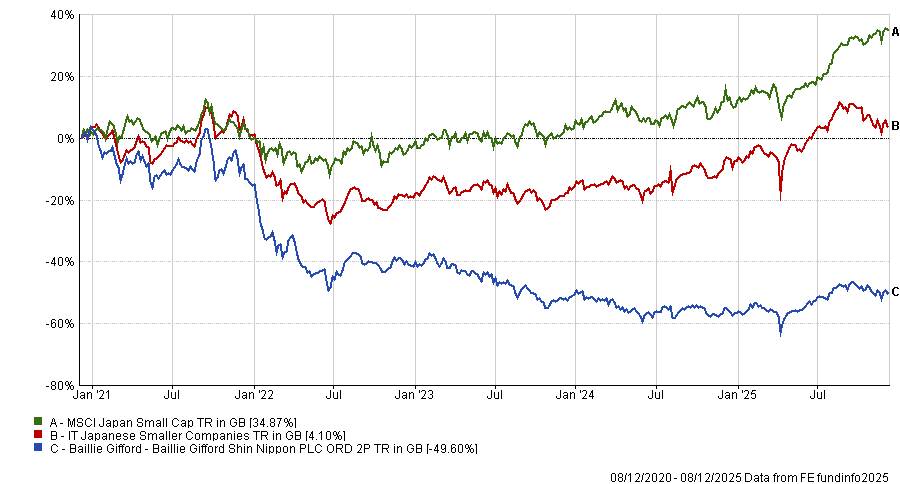
Source: FE Analytics
“[Shin Nippon] is currently the dog of the investment trust world,” said Lum, who worked as deputy manager on the trust until May 2025, when he was promoted to lead. “We have gone through a period of horrendous performance and there is no getting away from that. But there is opportunity there – it is an incredibly exciting and daunting challenge.”
He noted that the trust’s focus on growth has had a negative impact at a time when value has outperformed. In addition, large-caps have dominated while small-caps have lagged.
“And, when it comes to geography, Japan has not been the most attractive place to be over the past few years,” Lum said. “Yet I believe Japanese small-caps are probably the most overlooked corner of the global equities market.”
Despite the trust’s “absolutely horrendous track record over the past five years”, Lum said he will retain the trust’s historic focus on long-term growth, even while he implements changes.
First off, the previously 70-stock portfolio has been shaved down to 60, exiting a number of names where the investment case did not work out, valuation upside was no longer there or due to companies being acquired.
“There is a level of churn here that is slightly above average but we remain very long-term oriented,” Lum said.
He added that too many holdings had been “too similar in nature”.
“When things went down, they went down together, compressing valuations,” Lum said. “As such, one thing I am keen to do is continue looking for growth but across a wider variety of industries that may not scream growth investing, such as real estate.”
The trust has also relaxed its market capitalisation bias, with Lum noting previous management teams “really shot themselves in the foot” by limiting the prospective investment universe to companies below a ¥150bn (£720m) market cap.
“We have revised this now, aligning with the benchmark [MSCI Japan Small Cap index], which gives me a bit more flexibility to find the best investment opportunities,” he said.
In addition, Lum said he is trying to better articulate to clients why a company is in the portfolio, breaking each investment case into five attributes: opportunity, edge, scalability, alignment and sustainability.
Capitalising on opportunities
Lum argued that there are plenty of opportunities to be found in the niche asset class which are often ignored due to a “laundry list of problems” with the Japanese market at large.
“People point to Japan’s ageing society, huge lack of labour – specifically IT expertise which is in very short supply – and the fact it is sandwiched between China, which is increasingly dominant in the region, and the US, which is becoming a less reliable partner,” said Lum.
“And there are other problems, from currency to interest rates to structural deflation now turning to stagflation and so on.”
He acknowledged there are “valid observations” but that small-caps are far less impacted by these issues than larger companies in the region.
“Social challenges are an opportunity for a lot of smaller companies, which can benefit by fixing them,” he said.
As an example, he turned to Japan’s lack of labour issue, pointing to top 10 holding Katitas, a 2.8% position in the portfolio.
“In Japan, there is a cultural dislike of old properties, with 15% of the market pre-owned versus 85% being new houses,” Lum said.
“That is partly because of the number of earthquakes meaning people want to be sure their property has structural integrity but there is also a deep dislike of things that have been used by others before.”
For a society with a structural lack of labour, it is far more efficient to refurbish an old house rather than build new all the time, he argued.
“Katitas is dominant in [the retrofitting and refurbishment market]. After all, what do you do with abandoned pre-owned houses when you have a declining population and ghost towns in rural areas? These can be bought for next to nothing, done up and then sold on using a fraction of the labour needed to build new houses.”
The average investor is underexposed to the yellow metal, according to the firm's head of research.
The average portfolio should have around 15% in gold to benefit from the significant upside still in the asset class, according to Ernst Knacke, head of research at Shard Capital.
Knacke’s team has remained bullish on the precious metal this year, with Shard’s portfolios holding anywhere from 15% to 20% in physical gold bullion or mining equities, depending on clients' risk tolerance.
This allocation is relatively high compared to conventional wisdom. Earlier this year, for example, Fidelity International suggested an allocation of 5% to 10% would be suitable for most investors.
However, Knacke is not alone in favouring a higher position in gold, with precious metal asset manager Sprott suggesting a 10% to 15% allocation within a diversified portfolio. Veteran US hedge fund manager Ray Dalio argued that a 15% allocation to the yellow metal made sense at the moment.
Gold bugs have been rewarded for their bullishness this year, as the price of gold surged to more than $4,200 per ounce while the S&P GSCI Gold Spot rocketed up by 49% in sterling terms. This outperformed both the S&P 500 and the MSCI World, as demonstrated by the chart below.
Total return of indices YTD
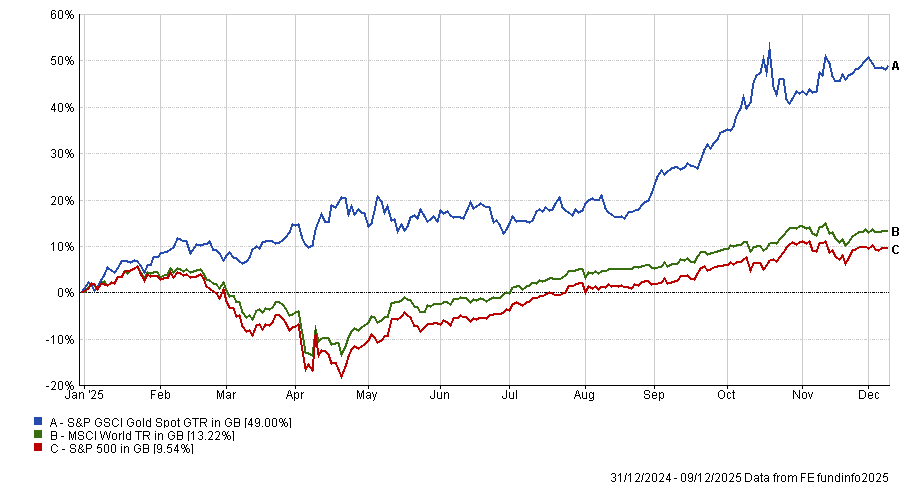
Source: FE Analytics. Total return in sterling.
As gold has soared, experts have been divided between those who remain bullish and those who have started to take profits.
Knacke has remained undeterred by concerns over valuation and said the “fair value of gold is whatever the market says it is”. Investors should consider $4,000 per ounce to be the “new floor” of the gold price, not the peak and the yellow metal could have much further to run, he suggested.
“We’re loaded up on gold, but if anything, signals are telling me I should be buying more of it,” he said.
Part of his continued bullishness is the decline of the dollar. The US currency has struggled this year, partially due to US president Donald Trump’s approach to fiscal policy, causing concerns over its status as the reserve currency.
Knacke said markets might have reached “peak dollar”, leaving central banks and investors struggling to find an alternative to fill the gap as a reserve asset. While he said this trend of de-dollarisation will take multiple years to occur, gold could be a big beneficiary.
The evidence of this can be found in central banks' attempts to increase their gold exposure this year, rather than buying US treasuries, Knacke said.
Indeed, 53 tonnes of the precious metal were bought by central banks in October, according to data from the World Gold Council.
Monthly reported central banks' gold activity

Source: World Gold Council, IMF, Respective central banks. Data to 31 October
This trend of central banks buying gold could continue over the long term, Knacke said.
Governments have entered a “new fiscal age” in which they run increasingly high debts and deficits that they expect central banks to fund by buying more treasuries, leading to more inflation volatility.
Central banks searching for a reliable store of value will increasingly find themselves turning to gold, rather than relying on US treasuries, he said.
Additionally, higher market volatility on the back of elevated inflation means years such as 2022, when bonds “did not protect you in any way”, will become more common. This will backfire on investors who are overexposed to bonds and encourage them to seek other ways of protecting themselves from volatility, Knacke predicted.
“I think people will realise that to protect themselves from the uncertainty and volatility of their equity exposure, gold is as good, if not better, an alternative than bonds,” the strategist said.
As a result, gold should become much bigger parts of investors’ portfolios moving forward, which should be supportive of a further rally in the metal, he said.
“I’m not saying investors are suddenly going to hold 40% of their assets in gold, but I don't think a 15% exposure would be absurd.”
The fundamentals of the asset remain broadly supportive and the yellow metal should have enduring appeal for investors, Knacke continued.
Unlike a commodity such as oil, which is used up and needs to be repurchased, “every ounce of gold we’ve ever mined in the world still exists today, just in a different form”. This will continue to make it compelling for investors who want a stable, reliable long-term asset, according to the Shard Capital team.
“What I have confidence in is that, as a store of value, gold is the most attractive asset. It has been for the last 5,000 years and probably will still be for the next 5,000 years,” Knacke said.
The Federal Reserve cuts rates by 25 basis points, although there were three votes against the move.
The Federal Reserve has cut rates by 25 basis points to 3.5-3.75%, marking the third reduction in 2025 and the lowest level in around three years.
Following yesterday’s Federal Open Market Committee (FOMC) meeting, Fed chair Jerome Powell reiterated his September message that “there are no risk-free paths” in policy. The central bank currently faces a trade-off between above-target inflation and a softening labour market.
The FOMC’s statement added: “In considering the extent and timing of additional adjustments to the target range for the federal funds rate, the Committee will carefully assess incoming data, the evolving outlook and the balance of risks.”
The phrase ‘the extent and timing of’ was added to the statement, interpreted by some economists as a signal that the Fed could pause until there is more data to support further cuts in 2026.
The decision to cut rates drew more opposition than the previous meeting in October - nine members voted for the cut while three dissented.
Two members (Kansas City Fed president Jeffrey Schmid and Chicago Fed president Austan Goolsbee) preferred no change. Stephen Miran, the ultra-dovish Fed governor, argued for a 50-basis point cut.
This compares to October’s 10-2 vote. In that meeting, Miran and Schmid had dissented.
PIMCO economists Tiffany Wilding and Allison Boxer said: “In the weeks since the previous meeting in October, several Fed officials had expressed discomfort with further rate cuts. Indeed, two officials dissented outright at this meeting by voting to hold the rate steady (and one official voted to cut 50 basis points).
“Four officials used the new economic projections – or ‘dot plot’ – to show they would have preferred to pause in December. Consistent with this sentiment, the statement changes reflected a committee poised to hold rates steady after cutting rates by 75 basis points over the past three meetings.”
Atakan Bakiskan, US economist at Berenberg, pointed out that three votes against the majority decision mean the Fed has had as many dissents since July as it had over the preceding 47 meetings.
“A fragmented Fed will most probably shape next year as well,” Bakiskan said.
“The Fed statement adopted a slight hawkish tone and added the new phrase ‘the extent and timing of’ to describe potential additional adjustments to the target range for the federal funds rate - the same language the Fed used in December 2024 when it signalled a pause in rate cuts, which lasted until September of this year.”
Forty equity funds have delivered top-decile returns in 2025 despite suffering bottom-decile maximum drawdowns earlier in the year.
Battery technology ETFs, AI-focused funds and North American growth strategies have staged remarkable recoveries in 2025 after turning double-digit drawdowns into market-beating returns, Trustnet research shows.
The year has tested investors’ nerves with sharp corrections across technology and growth sectors. Tariff concerns, AI valuation worries and cryptocurrency volatility triggered significant drawdowns in the opening months on 2025, with some funds falling more than 20%.
Yet these same themes have driven the strongest rallies of 2025. Investors repeatedly returned to AI infrastructure, electric vehicle technology and disruptive growth stocks after each sell-off, pushing many funds that suffered the worst drawdowns back into top-tier performance territory.
In this research, Trustnet reviewed fund performance across the Investment Association's 23 equity sectors. We identified funds in the top decile for total returns but bottom decile for maximum drawdown in 2025. Of the 2,393 funds in these sectors, 40 fit the criteria.
Performance of L&G Battery Value-Chain vs sector over 2025
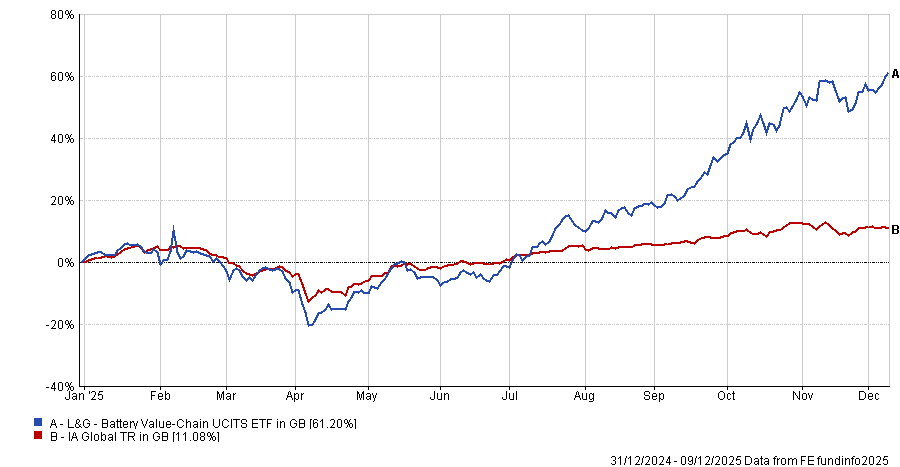
Source: FE Analytics. Total return in sterling between 1 Jan and 10 Dec 2025
The fund that has made the highest return this year despite being hit by a bottom-decile drawdown is L&G Battery Value-Chain. It made 61.2% return over 2025 to 10 December after recovering from a 24% maximum drawdown in the first quarter.
L&G Battery Value-Chain invests in battery technology and mining companies, aiming to offer exposure to the increased demand for innovative energy storage created by the continued growth in areas like consumer electronics and electric vehicles.
The first quarter’s drawdown was caused by depressed lithium prices weighing on the performance of lithium miners and worries about US president Donald Trump’s tariffs. Tesla was the ETF’s biggest detractor over the quarter, falling 35.8% as tariffs threatened to hike the price of components impossible to source from the US.
Like many of the funds in the below table, L&G Battery Value-Chain bounced back strongly from the tariff upset and rallied hard as investors continued to pour money in related themes such as artificial intelligence (AI), disruptive technology and growth stocks.
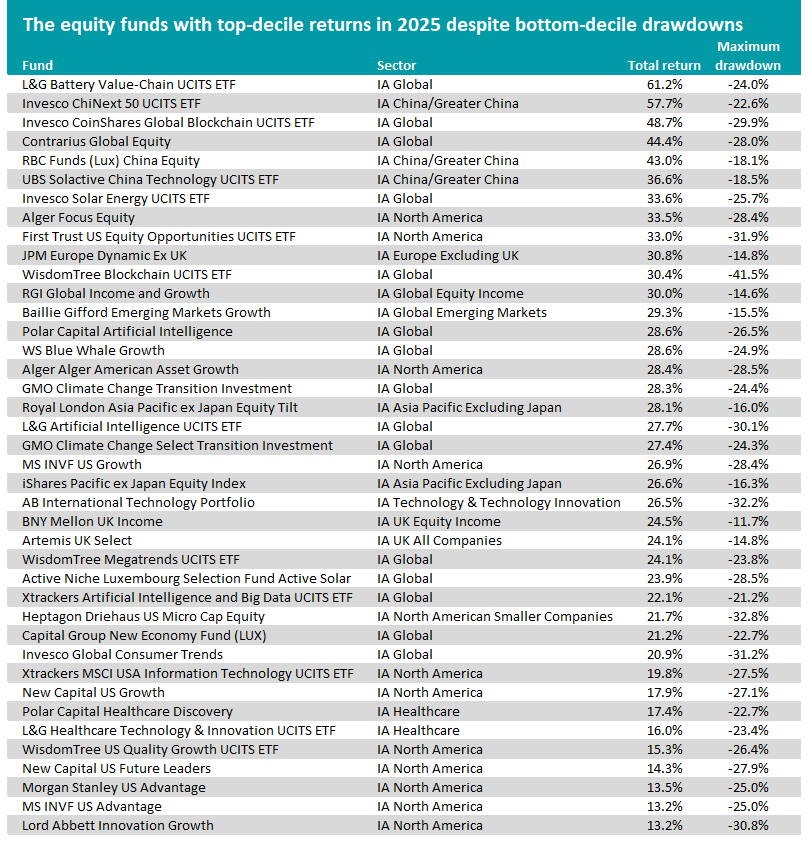
Source: FE Analytics. Total return in sterling between 1 Jan and 10 Dec 2025
Most of the funds that were hit with a bottom-decile maximum drawdown but still went on to make first-decile total returns reside in the IA Global sector – 15 of the 40 on the shortlist.
Three of the global funds – Polar Capital Artificial Intelligence, L&G Artificial Intelligence UCITS ETF and Xtrackers Artificial Intelligence and Big Data UCITS ETF – focus on AI, which has been the overriding theme of 2025.
AI stocks have surged in recent years as investors flocked to companies developing the emerging technology and those building the infrastructure needed for its continued growth, although they have stumbled at points in 2025.
Technology underperformed other major sectors in 2025’s opening quarter as investors questioned valuations and stocks dropped hard. Nvidia fell around 31% year-to-date by April because of US tariffs and export controls on AI chip sales to China.
Markets reversed direction when Q1 earnings showed AI revenue growth, with Nvidia’s data centre revenue up more than 70% year-on-year. Nvidia gained roughly 45% from its April low by early June.
Further falls in AI stocks in October and November reflected concerns that valuations exceeded fundamentals and that AI spending would not produce profits. However, investors returned to the AI trade as cloud and data centre spending on AI continued, with forecasts projecting data centre capital expenditure to increase from about $600bn in 2025 to several trillion by 2030.
In a recent update, Polar Capital Artificial Intelligence co-manager Nick Evans said: “It is important to remember that volatility is a normal feature of new technology cycles. Between 1995-98 – the early years of the internet infrastructure buildout but before the dot.com bubble – the Nasdaq gained 354%.
“However, this strong period was punctuated by seven corrections of greater than 15% during the period. We believe the current backdrop remains highly reminiscent of the mid-, rather than late 1990s. Put differently, while there are clearly some pockets of overexuberance and chatter about a so-called AI bubble, we strongly believe this is the end of the beginning rather than the beginning of the end.”
Meanwhile, Invesco CoinShares Global Blockchain UCITS ETF and WisdomTree Blockchain UCITS ETF are currently in the top decile of the IA Global sector this year but suffered large maximum drawdowns earlier.
This reflects the volatile performance of cryptocurrencies, which have surged but sold off in the first quarter and again in November as investors took profits and pulled money from crypto ETFs.
Outside of global equity funds, 11 members of the IA North America sector appear in the table of those that have overcome bottom-decile drawdowns to make top-decile returns.
A common theme among these funds, which include New Capital US Future Leaders, Morgan Stanley US Advantage, Xtrackers MSCI USA Information Technology UCITS ETF and Lord Abbett Innovation Growth, is focus on growth and/or tech stocks. As alluded to above, these stocks have been at the centre of 2025’s sell-offs but have also rallied hard as investors bought the dips and quickly returned to them.
Corporate balance sheets remain resilient while sovereign debt deteriorates, challenging traditional views.
The long-held belief that government bonds represent the ultimate risk-free asset is crumbling, according to Sarang Kulkarni, co-manager of Vanguard’s Global Core and Strategic Bond funds.
Traditionally, sovereign bonds have been viewed as the risk-free benchmark for discounting cashflows, underpinning valuations across global markets.
However, mounting fiscal pressures are eroding investor confidence in sovereign creditworthiness.
According to the OECD’s Global Debt Report 2025, global borrowing surged to $25trn in 2024, over $10trn above pre-Covid levels and nearly triple 2007 figures. Meanwhile, sovereign debt issuance in OECD countries was $16trn last year and is predicted to hit $17trn by the end of 2025, with refinancing needs reaching $13trn – around 80% of gross borrowing.
As such, outstanding sovereign debt is predicted to reach $59trn in 2025, which pushes the aggregate debt-to-GDP ratio to 85%. This is nearly double 2007 levels.
Attempts by governments to curb debt have so far not been enough to move the needle.
Global sovereign and corporate bond issuance in dollar terms
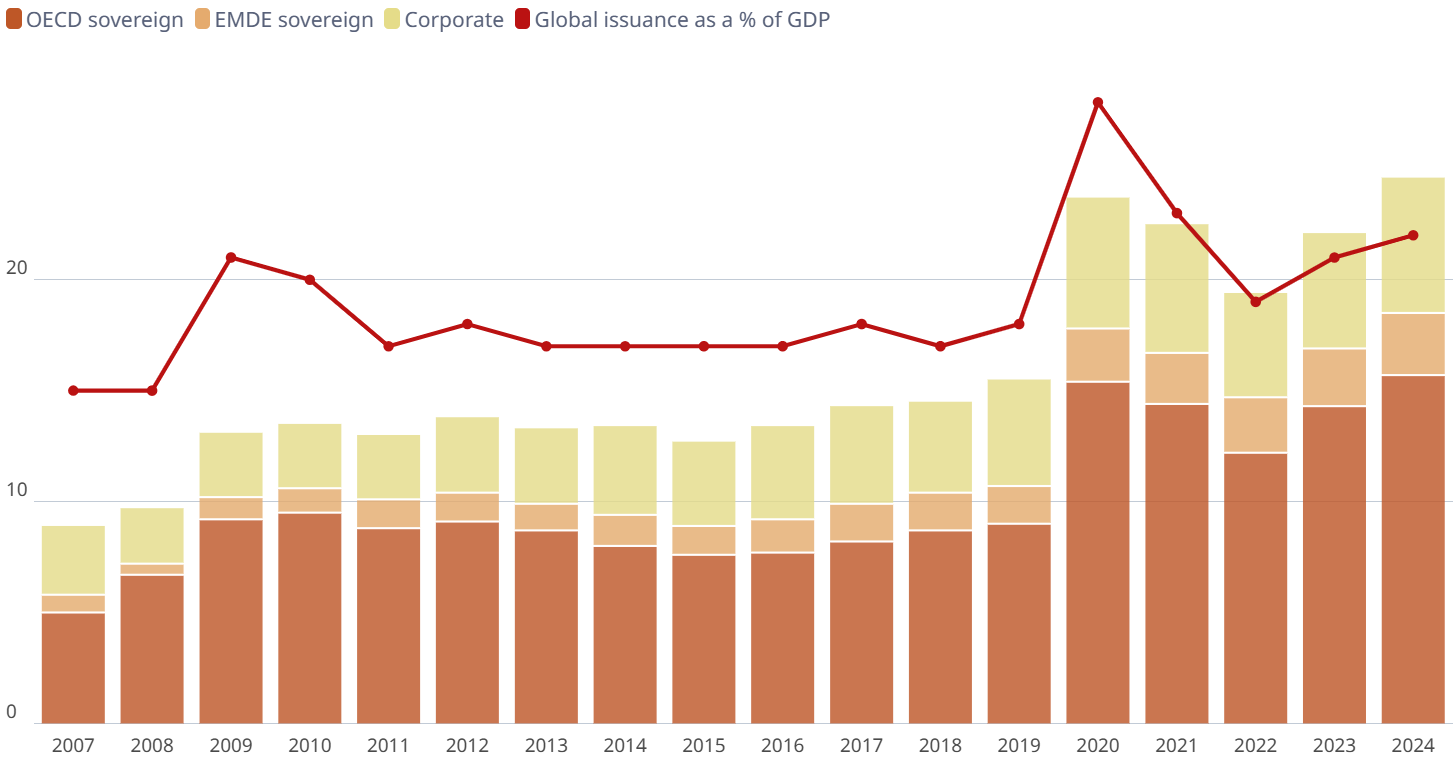
Source: OECD
This mounting debt burden has led managers like Kulkarni to question why governments are still treated as safer borrowers than corporates with stronger balance sheets.
After all, if a company comes to the bond market but makes no profit and keeps piling on debt, all while management has no support to make any changes to ensure that it is competitive and has a long-term future, most bond managers would likely reject it.
Yet Kulkarni said “this description [applies to] pretty much every sovereign out there at the moment”.
“When I first started working in fixed income, everyone said that the sovereign curve is a risk-free rate. Today, even the market has stopped believing that,” he said.
“Ever since risk-free swaps have been introduced, like SONIA, there has been a gradual and increasing premium between the term structure you have in these swaps versus what you have in the government bond curve. The market is treating government bonds like credit.”
In contrast, corporate bonds have demonstrated “a reasonable amount of fundamental strength” and have remained robust over decades, with balance sheets far stronger than the “ongoing deterioration of government balance sheets”.
This is having an impact on credit spreads.
Credit spreads are essentially the gap between the yields of government bonds and corporate bonds. When spreads are tight, meaning the gap between the two is small, investors feel confident that companies are financially strong and unlikely to default. When spreads are wide (i.e. the gap between the two is bigger), investors see more risk.
Therefore, tighter spreads typically suggest investors see little additional risk in corporates versus sovereigns. As such, many managers want to see wider spreads.
As shown in the left graph below, there is a surge in government bond yields underscoring rising fiscal burdens. The other graph - using the US and Russell 1000 as the example - shows how government debt is rising faster than corporate leverage, which looks more stable.
Government gross debt as a % of GDP and US government debt to GDP vs Russell 1000 long-term debt-to-capital
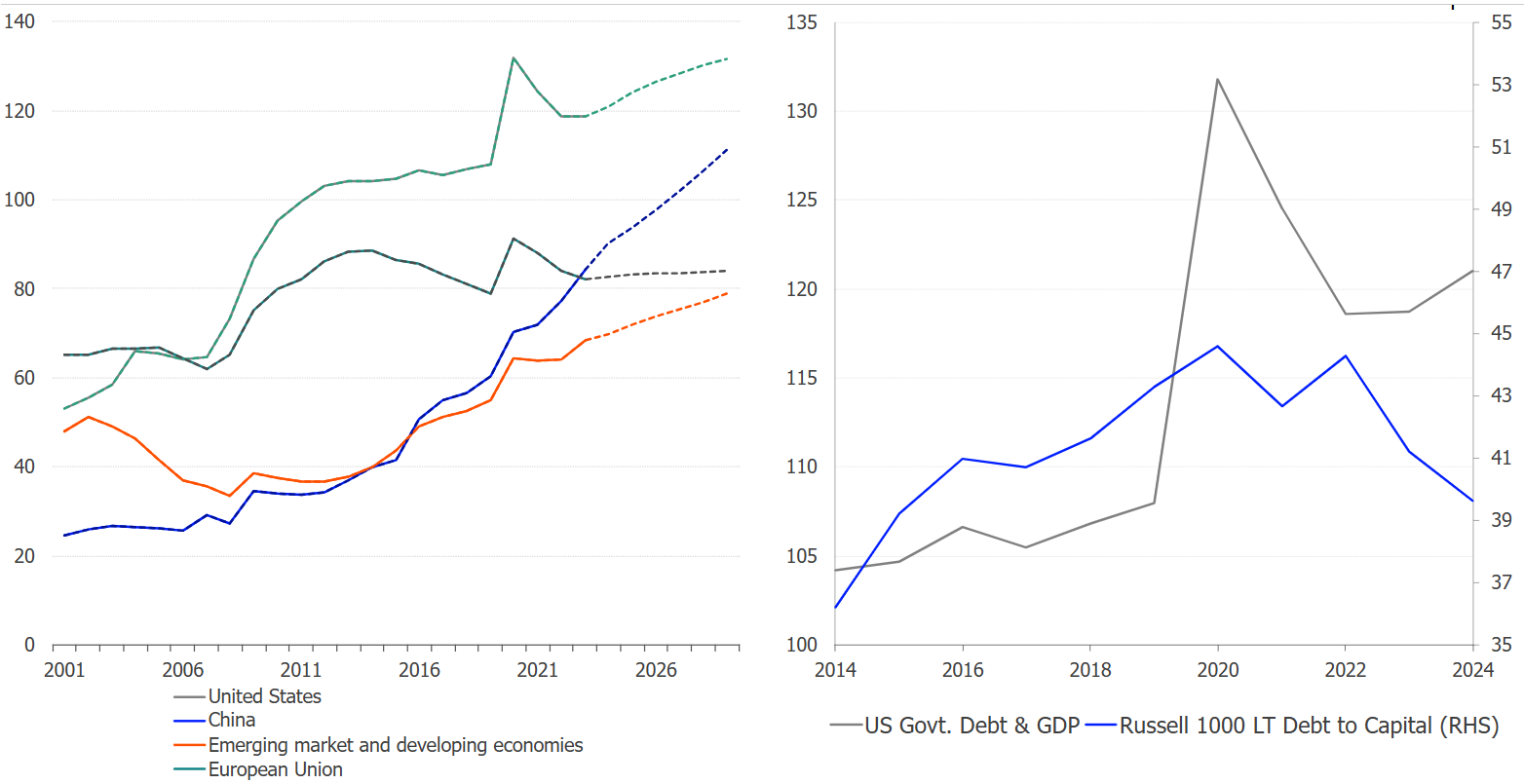
Source: FTSE Russell, IMF/LSEG. Data as of 31 December 2024.
Kulkarni said that tightening credit spreads are telling a different story than has been the norm – as is shown in the graph above, it seems the issue is more about government bond underperformance.
“Who is to say that credit spreads are too tight?” Kulkarni argued. “They are just a relative value between a corporate and a government. What’s actually happening is the government is getting worse while the corporate is staying where it is.
“During the eurozone crisis, corporate bonds from Italy, Portugal and Spain regularly traded inside their sovereign curves. Even now, this pattern is starting to emerge in US markets.”
If sovereign credit worthiness continues to deteriorate while corporate balance sheets prove to be more stable, then corporate bonds could trade even tighter than current levels suggest, he suggested.
“If you look at a place like Japan, Japanese corporate bonds have traded as tight as 12bps over the sovereign curve, so we still have a long way to go,” Kulkarni said.
“This whole paradigm we have is that sovereigns are the risk-free curve and, through that lens, when you look at corporates they seem tight based on the past. But there is potential for them to go tighter.”
FundCalibre’s Darius McDermott looks at the likelihood of Chinese stocks continuing to outperform from here.
Despite a shift in government policy towards a more pro-growth stance in September 2024, few would’ve predicted China to be the leading global equity market in 2025, returning almost 25% to investors year-to-date.
The turnaround is stark when compared with 2022 and 2023, when the MSCI China fell 14% and 18% respectively. But investor uncertainty remains – on the one hand the likes of Goldman Sachs believe Chinese stocks could rise by about 30% through the end of 2027, aided by policy tailwinds and reallocation of global and household assets – while others are quick to point to slowing growth, a property crisis and weakening corporate earnings.
The MSCI China is now on a forward P/E of 13.8x, with the adjustment bringing it towards its historical average. But I’d argue that if you scratch beneath the surface there are still plenty of opportunities to be had for good stock pickers.
For example, I recently caught up with Fidelity China Special Situations manager Dale Nicholls, who was keen to point out that, with the exception of technology, most other sectors have had consistent earnings downgrades in recent times. However, he says there are signs of that turning.
Alongside the political pivot and geopolitics, AI has been one of the leading drivers of the equity rally in China. At the start of the year, DeepSeek shook financial markets when it announced the development of an AI model with the same functionality as ChatGPT, but at a significantly cheaper cost.
Nicholls is quick to highlight that, despite the strong returns from Chinese tech firms, investment in AI in China is about 18 months behind the US, indicating the main driver to the US could easily feed through to China in the not too distant future. Let’s put a bit of meat on the bones of demand for AI in China – it accounts for 50% of demand for industrial robots; 60% of new cars in China have advanced driver-assisted solutions; and China ranks number one globally for AI patents with a 50% market share.
The turn in earnings is very important. The big drag has been on consumption – so we have seen weak consumption and consumer confidence and this is tied to two things – perceptions around income and perceptions around assets.
Nicholls cites a quartet of areas he has targeted in markets. The first, and biggest of these, is industrials, where he says exposure is broad, pointing to the wider market still understating the competitive nature of a number of Chinese industrial companies. Others include the consumer, healthcare and, perhaps most interestingly of all, the property sector.
Matthews Pacific Tiger fund co-manager Andrew Mattock agrees that investors should focus more on returns driven by the broader economy and earnings growth – with figures from the last quarter looking encouraging across most sectors, with the exception of the consumer and real estate.
He says: “Financials, particularly life insurance companies, performed well. We are seeing a structural shift as savers move from putting savings into property or on deposit and instead into life insurance investment products. We also saw robust earnings in utilities, materials and industrials, including electrical vehicle (EV) battery suppliers, and healthcare, e-commerce, internet platforms and IT.”
We are still in the bottoming phase for the property sector and while we are unlikely to return to the strong markets seen previously, there now appear to be opportunities at good pricing points. Mattock says the property market remains the single most important factor in supporting China’s economic expansion, adding that real estate has experienced month-on-month price declines since mid-2021 – something which hits consumer and household confidence.
Beyond earnings, the other major factor holding Chinese markets back from broadening out is tariffs and the lack of certainty around them. There are a number of considerations here, not least that not only is the Chinese government prepared for tariffs – with only 3% of the MSCI China’s revenues linked to US exposure – but a recent meeting between Donald Trump and Xi Jinping does offer confidence that a full deal can be made – which would be a positive for companies, consumers and markets.
If an agreement is upheld, China would face tariffs of around 47%, but we must remember China survived paying 25% in Trump’s first tenure, while on this occasion others are paying while China’s own economy is getting stronger.
The final point I want to touch upon is that the Chinese government is placing a greater focus on the domestic economy – resulting in an increasing preference among Chinese consumers and corporates for Chinese brands and local suppliers. Foreign investors only own around 3% of the China A-Share market, meaning domestic investors dominate sentiment and they have remained cautious until recently, with figures from Allianz Global Investors showing there are around $7 trillion of “excess savings”. That’s about half the size of the China A-Share market. If that starts to move, the market will re-rate at pace.
Chinese corporates also have around $2.4trn of cash on their balance sheets. Regulators have also sought to improve shareholder returns, with share buybacks in China A-Shares reaching record levels in 2024. While many companies previously only paid dividends once a year, a number are now introducing an interim dividend. Regular payments are another boon for retail investors – encouraging them to come off the sidelines.
Despite the recovery, valuations in China still look attractive. The 12-month forward price-to-earnings for the MSCI China is at roughly a 40% discount to the S&P 500. Clearly there will be more volatility, but this should also bring greater opportunities at a time when finding value across global markets is challenging.
Those looking for a pure China offering might consider the JPMorgan China Growth & Income trust or a domestic-focused offering like Allianz China A-Shares, which targets sustainable growth businesses at reasonable valuations in a 50-70 stock portfolio. Those who are warier may look to an emerging markets offering like Matthews Pacific Tiger or M&G Global Emerging Markets, which have 36% and 24% in China respectively.
Darius McDermott is managing director of FundCalibre and Chelsea Financial Services. The views expressed above should not be taken as investment advice.
J. Safra Sarasin identifies five crucial investment themes spanning short-, medium- and long-term horizons.
A structural policy pivot in China, US mid-term elections and waning performance from defensive sectors are just some of the events that equity investors should be keeping an eye on as we move into 2026, according to J. Safra Sarasin’s Wolf von Rotberg.
Von Rotberg, equity strategist at J. Safra Sarasin Sustainable Asset Management, has identified five themes that will shape equity markets across different time horizons, warning that historical patterns and valuation anomalies suggest investors should prepare for more modest returns in 2026.
Defensive recovery nearing completion
The outperformance of cyclical sectors versus defensives peaked at the end of September and defensive sectors have outperformed by around 9% since then.
Von Rotberg attributed this shift to a combination of factors, such as the general equity weakness in October and November, doubts over the US’s economic strength and a resurgence of healthcare (one of the defensive sectors alongside consumer staples and utilities).
“Following the strong Q4 rebound, the defensive recovery appears near completion,” he said.
“Sustained outperformance would require further softening of the US cycle and a continued decline in US yields and inflation expectations – scenarios we do not anticipate. Instead, a stabilising macro environment and moderate upside for inflation expectations are more likely, reducing support for defensives.”
Energy sector valuation disconnect
He also argued that the energy sector presents a striking valuation anomaly. At around $63 per barrel, Brent crude remains near its lowest level in over four years but the global energy stocks remained relatively stable in 2025.
Von Rotberg noted that the sector has been flat over the past 12 months despite a 15% drop in Brent prices, and energy stocks are currently trading as if oil were at $100 a barrel, rather than below $65.
“This divergence marks the widest gap between oil prices and energy sector valuations in at least a decade, posing downside risks to the sector,” he said.
AI trade transforms from build-out to built-in
Artificial intelligence (AI) has been dominating the headlines in 2025 but von Rotberg said “the AI trade is not ending; it is transforming”. By this, he means the euphoria that “indiscriminately lifted the entire AI value chain” is changing into a more measured approach towards the disruptive technology.
“The market focus is shifting from infrastructure build-out to adoption and monetisation. While we believe semiconductor demand will remain robust, we foresee increasing competition from proprietary chips of hyperscalers and easing supply constraints heading into 2026,” he said.
“Semiconductor margins – excluding Nvidia – are at typical cycle highs and likely to peak in 2026, limiting the scope for renewed outperformance.”
Different sectors will benefit from this transition. Von Rotberg argued that communication services and software look set to benefit from increasing AI integration and monetisation, which should soon start to show up in earnings and provide a lift to these sectors as soon as next year.
However, the broader economic impact will take longer to emerge as customised products become widely available and business adoption rates rise. But this is likely to be “the last leg of the trade” and only become visible in economic data after 2026.
Mid-term years present historical headwinds
Conventional wisdom suggests that US president Donald Trump only needs to prop up the economy and stock market ahead of next year’s mid-term elections in order to secure victory for Republican candidates. However, von Rotberg said “history suggests that it is rarely that simple”.
Citing data going back to 1945, he noted that equity market gains were typically lower in mid-term election years than in non-election years. US equities have risen by an average of 9% per annum since 1945, yet the average price gain in mid-term years falls to 4%.
“Historical data warrants further caution regarding 2026, particularly given the market’s strong trajectory over the past three years,” he warned.
“If the US equity market holds its value through year-end, it will be only the sixth time since 1945 that the index has risen by more than 75% over a three-year period. In four of those six previous instances, the market declined the following year. The only exceptions – where the market extended that 75% gain – were 1998 and 1999.”
Therefore, it looks like it will be difficult to argue for another year of strong double-digit returns from the US, unless it takes the form of a dot-com-style ramp-up, which he sees as unlikely. His end-2026 S&P 500 target of 7,400 reflects a moderately optimistic view for the months ahead, but is a deceleration from the previous three years.
China's structural policy shift
Chinese equities posted one of the strongest performances in the first half of 2025, then stalled more recently as strong performance was not supported by earnings upgrades. Von Rotberg pointed out that consensus earnings per share for the MSCI China index rose 4% year-to-date, compared with a 30% rise in the index, “leaving most of the heavy lifting to surging valuations”.
The strategist added that one reason why China has failed to generate earnings as strong as other regions is the supply-driven nature of Chinese macro policy. Oversupply and cut-throat competition with wafer-thin margins are the result of heavy state-driven investment into strategic sectors and decreasing domestic demand, meaning the expansion of the industrial base and surging exports failed to lead to significant shareholder returns.
“Yet this may be changing. Recent announcements signal a move towards a more balanced supply-demand framework. First, the government’s campaign against ‘involution’ – destructive competition – aims to arrest the decline in producer prices caused by manufacturing oversupply. A reflection of these efforts is the recent drop in fixed asset investment, the first such decline since 2020,” von Rotberg finished.
“Second, at the Fourth Plenum in October, China’s Five-Year Plan explicitly identified domestic consumption as the primary driver of future GDP growth. This pivot – less supply-side stimulus, more demand-side support – should bode well for domestic manufacturers over the long term.”
Funds from Macquarie, Artemis and Robeco, among others, performed well.
Nine emerging market funds have delivered top-quartile returns over the past one, three, five and 10 years, according to recent Trustnet research, with value investing being a consistent theme among these outperformers.
Emerging market equities are often seen as unpredictable because they have greater political instability, weaker institutions, less diversified economies and more volatile currencies than developed markets.
What’s more, lower liquidity, weaker corporate governance standards and less developed market infrastructure increase the difficulty of running stocks in emerging markets.
However, several funds have proven their ability to navigate these choppy markets over recent years and outperform their peers. As part of an ongoing Trustnet series, we examined the IA Global Emerging Market strategies, which delivered top-quartile returns over one, three, five and 10 years (the standard time frames used by most investors).

Source: FE Analytics. Performance to the end of November. Chart sorted by 10-year return.
The table above shows all the funds that made the shortlist in this research. As its ranked by 10-year performance, Macquarie Emerging Markets sits at the top. Led by Liu-Er Chen, the fund targets companies that have sustainable franchises that are trading below their intrinsic value.
The fund is overweight South Korea, where it has a 31.1% allocation – an 18.2 percentage point overweight the MSCI Emerging Markets index. MSCI says Korean equities are more tilted to the value factor than the wider emerging markets index.
Meanwhile, it is underweight the two largest emerging market economies – China and India.
Performance of the fund vs sector and benchmark over 10yrs
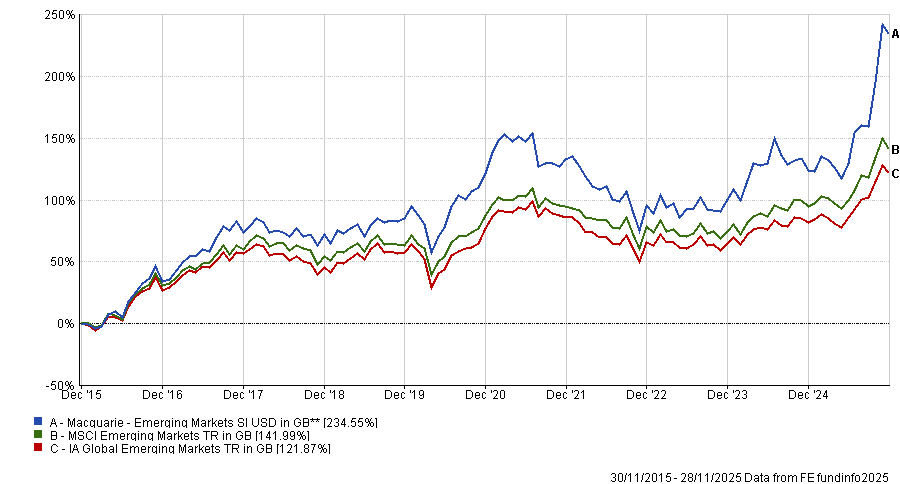
Source: FE Analytics. Performance to the end of November.
Over one and three-year periods, it is also the best-performing fund in the IA Global Emerging Markets sector due to top-quartile results year-to-date and in 2023. However, investors should be aware that the strategy did not always deliver, as seen by the bottom-quartile 19.9% loss in 2022.
Over the past five years, Artemis SmartGARP Global Emerging Markets Equity has been the top fund in the peer group. It has beaten its benchmark in every calendar year since launch, only faltering against the MSCI Emerging Markets in 2020 when it lagged by around 15 percentage points.
Performance of the fund vs sector and benchmark over 10yrs
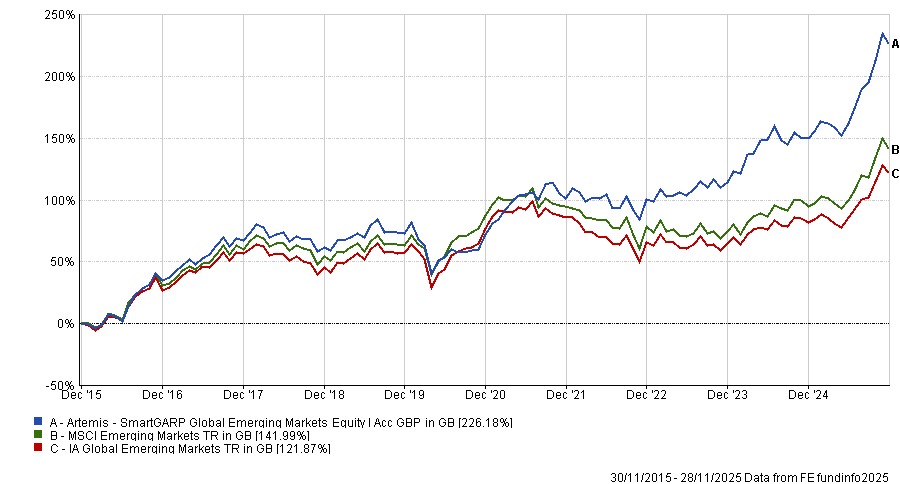
Source: FE Analytics. Performance to the end of November.
Led by FE fundinfo Alpha Manager Raheel Altaf, the portfolio uses the SmartGARP (growth at a reasonable price) process to target companies that are undervalued for their growth potential.
The strategy is well regarded by analysts at FE fundinfo, who said: “The fund blends rigorous quantitative analysis with the manager's qualitative judgement to navigate ever-changing market conditions.”
While the strategy is tilted towards value, the managers go “beyond pure value” by considering macro factors to create a more balanced portfolio. “This blend of systematic analysis and fundamental oversight makes the strategy more resilient across different market conditions and a strong candidate for a core emerging market equity allocation,” FE fundinfo analysts said.
The largest strategy to make the shortlist in this research is the £2.5bn Robeco Emerging Stars Equities fund, up 158.9% over 10 years.
Performance of fund vs sector and benchmark over 10yrs
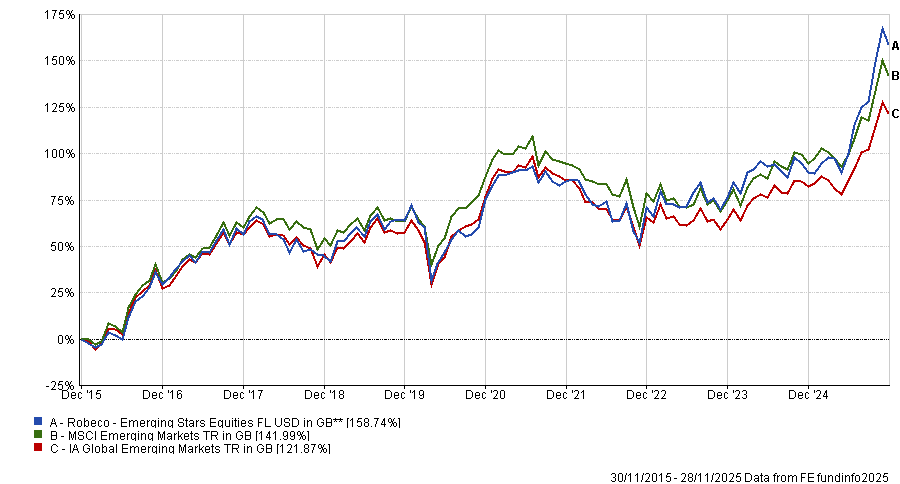
Source: FE Analytics. Performance to the end of November.
Managed by Jaap Van Der Hart and Karnail Sangha, it combines both top-down and bottom-up analysis to identify companies with a healthy business model at compelling valuations.
The portfolio is highly concentrated with around 35-50 stocks, with the largest position – Taiwan Semiconductor – representing 10% of the total assets.
Analysts at Rayner Spencer Mills Research (RSMR) said the team has considerable experience running emerging market strategies and has built up “considerable resources”, such as a dedicated Chinese analyst team to help find opportunities.
Because emerging markets “have a greater proportion of growth strategies”, Robeco’s value style can provide “something different” for investors hoping to diversify their exposure, RSMR analysts said.
However, while the high-conviction approach has led to strong overall returns, the strategy could prove volatile on a calendar-year basis. For example, while it delivered a top-quartile performance in 2023, it slid into the bottom quartile in the following year.
Another consistent option is the £1bn Invesco Global Emerging Markets (UK) Fund, which has also delivered top-quartile results over one, three, five and 10 years.
Performance of fund vs sector over 10yrs
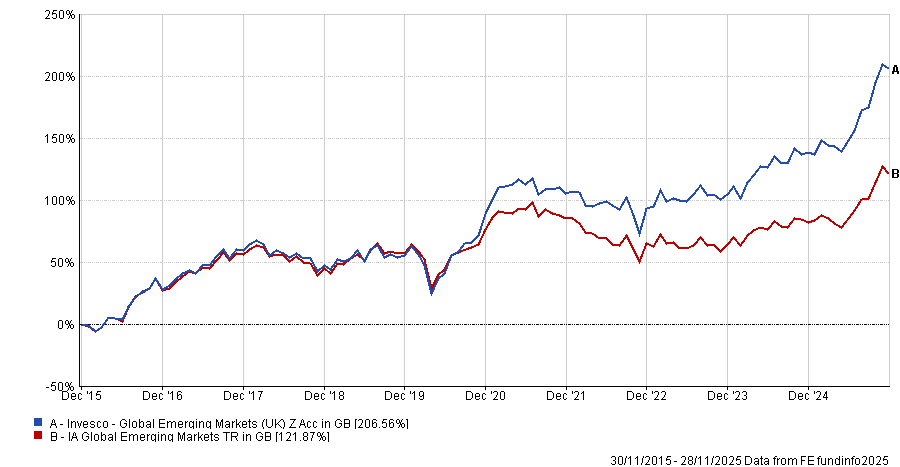
Source: FE Analytics. Performance to the end of November.
Led by FE fundinfo Alpha Manager William Lam and Ian Hargreaves since 2018, this is another value strategy targeting companies whose share prices are substantially below the team’s estimate of fair value.
Analysts at Titan Square Mile have awarded the fund with an ‘A’ rating, due to the team of “skilled portfolio managers” and a well-established process.
However, due to inflows this year, the team have been pushed to more liquid names, which has “reduced their ability to take meaningful positions in smaller, high conviction ideas”, analysts warned.
The Lazard Emerging Markets, Fiera Emerging Markets, GAM Sustainable Emerging Equity, RBC Funds Emerging Markets Value Equity and abrdn Emerging Markets Income Equity funds also made the list.
Previously in this series, we examined the funds that delivered top quartile results over one, three, five, and 10 years in Europe, global markets, the US and the UK.
The £2,000 limit will bite from April 2029 but experts say savers can still maximise tax relief by utilising their personal pensions.
Chancellor Rachel Reeves’ decision in the autumn Budget to impose a £2,000 annual cap on salary sacrifice has sparked concern among higher earners who rely on the mechanism to boost pension savings.
Lisa Picardo, chief business officer UK at PensionBee, said: “Salary sacrifice has long been an important planning tool for those in the workplace navigating tapering thresholds, reclaiming personal allowances when they hit earnings cliff-edges, or simply trying to build larger pension pots in a tax-efficient and disciplined way.
“The cap serves as a disincentive for employers to offer this facility, adding significant friction to this kind of planning.”
However, while the cap will limit National Insurance (NI) savings on contributions above that threshold, experts stress that there are still ways to be tax-efficient when saving for retirement.
One of the most notable options is to utilise a self-invested personal pension (SIPP) – a type of UK pension scheme that offers some tax relief and allows individuals to manage their own retirement savings.
Zohaib Mir, financing planner at EQ Investors, said: “The £2,000 NI cap only applies to salary sacrifice. Personal SIPP contributions are paid from income that has already had NI deducted, as they always have, so this rule doesn’t directly affect SIPP tax relief.”
But the question is whether it is best to move away from salary sacrifice – mostly done through auto-enrolment workplace pensions – and focus on growing your SIPP, to keep things as they are and take the NI hit or utilise both vehicles.
What does a SIPP have to offer?
When paying into a SIPP, the government adds tax relief at your marginal income tax rate up to the £60,000 annual allowance or 100% of your earnings – whichever is lower.
Investments held within a SIPP can also grow free from income and capital gains tax while dividends and gains remain inside the wrapper.
While most workplace pensions typically offer a sensible default fund and range of alternative funds designed to be simple and low-cost for members, a SIPP gives investors a broader menu of investment vehicles, including global funds, exchange-traded funds, investment trusts and more specialist or sustainable strategies.
As such, utilising a SIPP can help savers diversify more widely outside a UK-biased default fund and also align investments more closely with their own risk appetite or values.
“That extra choice is helpful for engaged investors, but it also brings more responsibility,” Mir said. “It’s easier to take on more risk than you realise, or to over-trade.”
What are your options?
Mir said there are three possible options for savers looking to build their pension pots and the right choice is dependent on earnings, employer terms and how much someone is contributing to their workplace pension.
The first option is to stop using salary sacrifice and pay into a SIPP instead. While this will give the saver more control and a wider investment choice, it does mean they will lose NI savings on the first £2,000 of salary sacrifice and any extra employer benefit tied to it.
Mir said this option is logical only for those who have already secured all available employer contributions and value the flexibility and control of a SIPP more than the NI saving.
Rachel Vahey, head of public policy at AJ Bell, added: “Most savers may want to continue paying into their workplace pension and take advantage of the employers’ pensions contributions on offer.”
This is because the employers’ pension contributions are effectively ‘free money’ and can make a big difference to someone’s final income in later life, Vahey said.
The next option would be to carry on as normal via salary sacrifice as this will still get income tax relief, although pension contributions above £2,000 will no longer get NI relief.
“For many people, the extra NI cost will be relatively modest and keeping things simple may be attractive,” Mir said.
“This can be reasonable where contributions aren’t far above £2,000 a year, or where the admin and complexity of changing arrangements outweighs the benefit.”
At the very least, savers should consider “maximising” what they can put aside via salary sacrifice ahead of the rule change taking effect in April 2029, Picardo noted.
The third option is a blend between the two, with savers using salary sacrifice up to the £2,000 cap and then topping up their pension savings beyond that via a SIPP.
“In practice, this is likely to be the default approach for a lot of higher or mid-earners,” Mir said.
“It provides a good balance where you can keep the available NI benefit, retain valuable employer funding and still have the option to use a SIPP for extra flexibility.”
Of all three options, Mir said this latter option is the “most broadly credible starting point”.
A “blended approach” of saving into an active workplace pension and a personal pension will work well for the majority of savers, Picardo agreed.
“Enjoying the benefits of employer contributions and salary sacrifice where possible through the workplace and channelling additional pension contributions into a personal pension to utilise the annual allowance, maintain tax efficiency, investment flexibility and pension engagement gives the best of both worlds,” she said.
The right mix will be highly personal to the individual but experts emphasised that pensions should not exist in a vacuum, encouraging savers to also consider other saving vehicles, such as ISAs, general investment accounts, higher-risk tax-advantaged investments such as VCTs and overpaying mortgages or other debt.
“For many people, the right answer will be a blend of pensions, ISAs and paying down debt rather than using just one wrapper,” Mir said.
Baillie Gifford's Roderick Snell backs Vietnam and China while cutting exposure to India.
Asia ex Japan is on the cusp of a growth surge, according to Baillie Gifford Pacific co-manager Roderick Snell. He cited a “triple growth scenario” underpinned by cheap valuations, structural resilience and rapid economic expansion.
“Two of the five largest economies in the world, China and India, are based in Asia and the region accounts for 60% of all GDP growth, about a third of all GDP and yet only around 8% of global indices,” Snell said.
“It has admittedly been a pretty poor place to invest for the past decade. If you had invested anywhere else in developed markets or the US, you would have made two or three times your money. It has been a disappointing place to be.”
Performance of MSCI Asia ex Japan vs MSCI World and S&P 500 over 10yrs
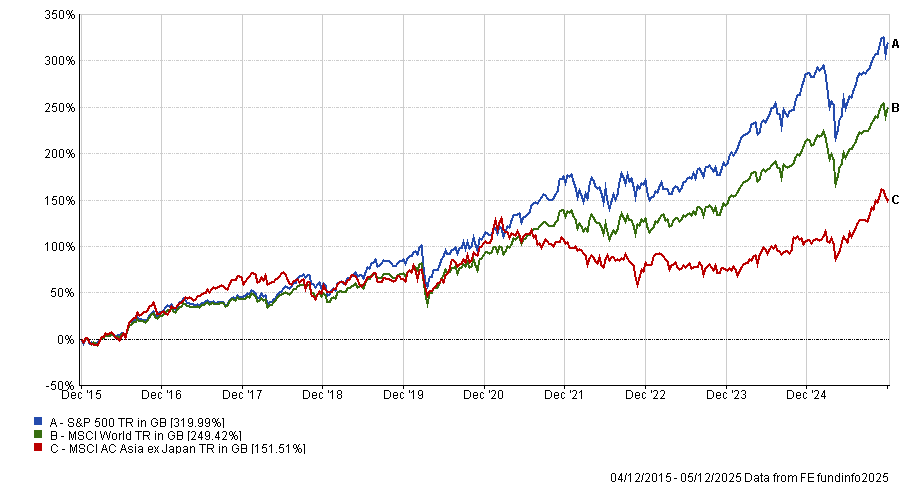
Source: FE Analytics
Despite a long period of underperformance, Snell said Asia ex Japan is now at a “major inflection point where we are going to have a golden period for the region” over the next five to 10 years.
He noted that valuations remain near-record discounts compared to developed markets, even as the International Monetary Fund forecasts faster growth for 90% of Asian economies.
In addition, despite a challenging multi-decade backdrop of aggressive US rate hikes and a strong dollar, the region has avoided crises thanks to low reliance on foreign capital and years of net outflows, Snell said.
Structurally, Asia is set to become the centre of global consumer demand, he predicted, with 80% of the world’s new middle class emerging from its domestic markets.
While the backdrop looks compelling, Snell warned that not every market will benefit equally – making selectivity critical.
As such, Baillie Gifford Pacific has leaned into Vietnam and China while taking a more cautious stance on India.
China: Capitalising on the resurgence
China has been “very weak” for the past three to four years, according to Snell, but he argued that conditions have now stabilised.
A couple of years ago, the Baillie Gifford fund was underweight China but Snell said he has been adding “significantly” over the past 18 months. It currently makes up around 40% of the fund.
“It’s a $17trn economy growing at 5% per annum,” he noted, adding that the government has shifted toward pro-growth policies and private sector backing – particularly in tech.
“China is now leading in many pivotal areas, such as electric vehicles, batteries and solar,” he said. “While there have been issues with the Chinese economy, we are past the worst.”
At the stock level, there are also lots of affordably priced opportunities. Snell pointed to coffee chain Luckin Coffee, which has outgrown Starbucks in China with 24,000 stores – 7,000 of which have been added in the past year.
“It knows how to grow but it has a pretty checkered past,” Snell said.
Upon initial public offer five years ago, Luckin faced a major accounting scandal and was subsequently delisted from the stock market. Snell said the company has since restructured and rebounded strongly.
“As it is not on the main exchange anymore, a lot of investors won’t even look at the company,” he said. “This means you can get China’s largest coffee franchise for a fraction of the price.”
Another example highlighted by Snell was Lufax, a wealth management and retail lending platform mostly serving small and medium-sized companies.
“At the moment, it’s trading on 0.1x price-to-book ratio and it has double its market capitalisation in cash – which it is paying out,” said Snell.
“Last year, investors got the entire market cap back in cash and we think that is going to happen again over the next 18 months. Plus, there is the chance this goes from 0.1x to 0.5x price to book.”
China also has world-leading businesses, particularly in areas such as new technology and green energy, with companies like hybrid car maker BYD Auto, battery manufacturer CATL, TikTok-owner Bytedance and online retailer Alibaba, he said.
Vietnam: The next Asian Tiger
The Baillie Gifford fund’s biggest overweight position is in Vietnam, which makes up around 10% of the portfolio’s assets.
Vietnam stands out to Snell as the strongest structural story in emerging markets because it has built a successful export manufacturing base – a foundation that historically enabled countries like Japan, Taiwan and China to ‘emerge’.
“It is the only country of any size that is doing that today, so we think it is likely to be the next Asian Tiger,” he said.
Domestically, the country is also at a major inflection point, Snell said, noting that the economy over the past few years has been “pretty weak”, largely due to Nguyễn Phú Trọng, General Secretary of the Communist Party of Vietnam until he died in August 2024.
“He could be described as a miserable Marxist as he put in place a big corruption clamp-down operation called ‘blazing furnace’,” Snell explained.
“This led to huge problems for the country, essentially prompting a mini property crash and a crisis in the bond and banking markets. Worst of all, no one was prepared to sign anything off in Vietnam which, when you were reliant on multinationals coming up to set up their exporting bases, was a big problem.”
He has since been succeeded by Tô Lâm, who Snell views to be “very much the opposite”, noting “he is all about the economy and growth and is far more business minded, [pushing] for 10% per annum GDP growth”.
“We are really starting to see changes on the ground as a result,” Snell said.
India: Too expensive
Over the past two years, Baillie Gifford Pacific has been funding its overweights in China and Vietnam by selling down India. It has gone from being an overweight in the fund – the second largest behind Vietnam – to being a “big underweight position in the portfolio”, said Snell.
India’s economy is growing steadily, but Snell warned that the lack of private sector investment to complement strong government spending could hinder its ability to sustain GDP growth.
But the big issue with India has been the valuation disparity, according to Snell.
“It has been one of the top performing markets over the past few years and we struggle to find stocks where we can realistically double our money over the next five years,” he said.
For example, he noted that Hindustan Unilever is growing at around 10% per annum in dollar terms but you have to pay around 50x price to earnings (P/E).
“For India’s largest supermarket chain DMart, it’s seeing similar levels of growth but is trading close to 100x,” Snell said.
Global political and economic events have been dramatic in recent years, yet stockmarkets have still made progress. This resilience is to be celebrated, but with so much uncertainty, this is no time for naïve optimism.
There are many contenders for the crown of the most naïve forecaster of the future but few loom larger in the public imagination than American political theorist Francis Fukuyama.
In 1992, shortly after the fall of the Berlin Wall, and as moderate leaders emerged across the rich world, he boldly forecasted ‘the end of history’.
His argument was that the time had passed when big political ideas would vie for supremacy, upending the world order regularly. Now he argued the world was settling into a gradual progression towards liberal, American-style democracy, built on moderation, democratic acceptance and ever-rising prosperity.
He now says that he is told two or three times a day on his X account that he was wrong. But in fact, the nuance of his views is a little more interesting than the original outlandish claim suggests.
His argument was not that the world would not face problems, but that it would drift towards order, democracy and growth, with many bumps along the way.
At first glance this theory looks ridiculous in the current moment. In the United States, Donald Trump has put forward a version of US political thought not seen for 100 years: abandoning internationalism, the immigration that has driven American growth for 200 years. In Europe, radical political parties on both the left and the right are in the ascendancy. Moderate governments across continental Europe looks imperilled and here in the UK the moderation of Keir Starmer has rapidly met with a deeply disapproving electorate and a surge towards more radical ideas. As far as the eventual dominance of Western American thinking goes, the growth of a one-state Chinese communist party to lead the second great superpower of the world seems to suggest otherwise.
Yet the true lesson of history when it comes to financial markets is that markets do not make progress when everything is fine and benign, it never really is. They make progress when the conditions are ‘good enough’ for ordinary people to make personal progress in their careers and businesses, so that they can push through the turbulence. Perhaps what we have learned from recent events is that however obsessed we are with the disruptive power of global leaders, the economy and stockmarkets have found a way through.
Markets do of course hate uncertainty and so classic logic suggests that they will be heavily disrupted disruptive forces. And yet, recent years tell us a different story. Had we forecast in 2020, when the streets of London were deserted from the greatest pandemic for 100 years, that the next five years would involve a major land war in Europe, the largest inflationary spike since the 1970s and the re-emergence of an unbound Donald Trump as the leader of the free world, we would have no doubt concluded that it would be a bleak period for stockmarkets.
The facts say otherwise. Over five years US shares have risen by just shy of 100% with the FTSE 100 up over 90%.
In search of an explanation for this extraordinary resilience, economists at first turned to the explanation of liquidity. After the pandemic, central banks pumped as much money into the financial system in five months as they did in the five years following the global financial crisis. This they argued, floated all boats, whatever the politicians threw at the world.
This argument begins to come apart from 2022 onwards when those same central banks, unnerved by rising inflation, begun to take liquidity out of the system. So, what has enabled the markets to keep rising despite the obvious problems?
For an explanation we must address the basic question of: what do markets really care about? The short answer to this question is earnings. They care that companies are earning cash that they can return to their investors as dividends or by buying back their shares to make the remaining shares more valuable. This is in fact all they’ve ever really cared about. Long-term studies from Robert Shiller and the CFA Institute show that in the period 1871-2014, almost all of the average 9.64% annual return of US shares has been explained by the amount companies have paid out and inflation. Just 0.27% of the return earned by shares is not contained in these two things.
Simply put, alongside the unsettling global events, the past three years have seen an explosion in company earnings, but specifically in the earnings of the largest US technology companies. Over the five years to the end of August 2025, the tech-heavy US Nasdaq index has seen the earnings of its shares rise by an average of 18.92% a year, an extraordinary rate of growth – fuelled more than anything by the growth of artificial intelligence.
There have been many markets that have lagged this growth and shrewd diversification has been critical, but ultimately the explosion of technological innovation appears to have picked up where liquidity left off, enabling markets to continue to rise whatever turbulence the world produces.
This then leaves us with a critical question; can it continue? Here investors must contend with two competing arguments.
On the one hand many argue that the explosion of artificial intelligence will result in such enormous productivity gains for companies in the coming years, such higher levels of efficiency and such new innovation that there is more than enough scope to usher in a golden period of stockmarket investment.
On the other though, some contend that enormous investment is being made in artificial intelligence, but it is having little impact on the bottom line of most big companies. In fact, a study by the Massachusetts Institute of Technology found that 95% of large US businesses have yet to turn their AI investment into fresh profits. Instead, they are finding that individual employees are downloading ChatGPT and finding wins in their own jobs, but the company is not yet profiting.
Sceptical voices also chime in that whenever major new general-purpose technologies appear to transform the world, there is an initial wave of optimism, but in reality, it can take decades for this to feed into real economic growth. Whilst all major forecasters believe AI will have a significant impact on productivity, the range of forecasts as to how big this will be in the coming decade vary hugely. In the meantime, businesses are spending hundreds of billions, often funded through debt, in an AI arms race to avoid falling behind.
It can be tempting in this context to look for hard answers from financial advisers and investment managers. “Come on then, which is it?” The truth is, we just don’t know. The complexity of the changes brought by AI upon the world are simply too diffused, too unknowable, to really understand whether we are facing a period of strong stockmarket returns or whether there will be a significant drawdown from stockmarkets along the way, as initial optimism fades.
Our judgement has always been that those who claim to know the answers to these questions are simply pretending to know more about the future than they do.
The good news is that there are techniques which enable sensible investment managers to bridge this divide, found in a disciplined approach which retains high levels of diversification at all times.
Such an approach must acknowledge that during boom periods for particular sectors, a portfolio will not participate as much as it could have. There will always be investors who will look at a diversified portfolio and complain that everything that was not invested in last year’s winners was lost money. Yet, diversification means that if sharp drawdowns do come in particular sectors, such as US technology, then there are sources of resilience to protect portfolios from short-term pain.
The portfolios managed by Albemarle Street Partners use 22 years of data to spread investments across a wide range of geographies, market factors and asset classes. This approach helps to build in investments that rise when others fall.
Such an approach requires acceptance that in order to build resilience into portfolios, we must be willing to accept we may not get all of the gains in the good times, but also offers confidence that when bad times come there are assets that have the potential to protect portfolios through the short-term ups and downs.
Most now agree that history is not over, that turbulence will continue in the world each year, governments will be upended, new technology will transform society but have lows as well as highs.
What does not changes is that discipline and diversification is the only rational approach for an unknowable future, because in the long-term, it is remarkable how effectively stock markets and economies can adapt to change and continue to deliver on the long-term goals of investors.
Charlie Parker is managing director of Albemarle Street Partners. The views expressed above should not be taken as investment advice.
Passives took the lion’s share, but a small number of active funds managed to catch DIYers’ attention.
Passive funds were the main choice for retail investors in 2025, with new net flows data from AJ Bell confirming a widespread preference for low-cost and no-fuss exposure to markets.
However, a small number of active portfolios convinced the platform's DIYers of their worth – chief among them JPMorgan Global Growth & Income.
Looking at the table below, which is based on net flows between 1 January 2025 and 2 December 2025, the growth in popularity of passive funds is “plain to see”, said Dan Coatsworth, head of markets at AJ Bell.
Most popular funds and trusts (all types) with AJ Bell’s DIY investors in 2025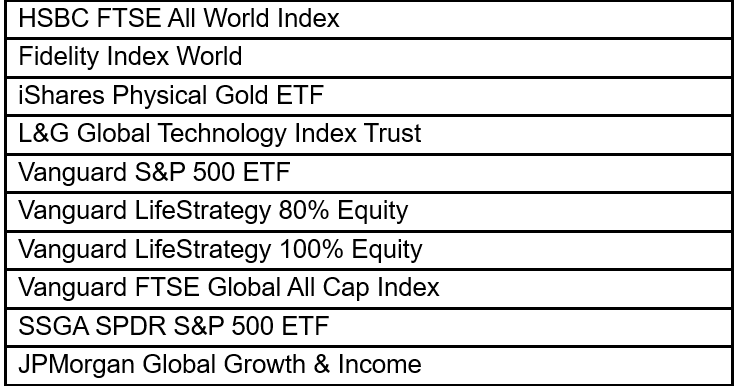
Source: AJ Bell
The most popular passive funds were ones providing broad exposure to companies around the world, gold, the technology sector and to the UK and US markets.
HSBC FTSE All World, Fidelity Index World, Vanguard FTSE Global All Cap Index and Vanguard FTSE All World all do a similar job – tracking a specific basket of global shares. This is useful for most investors, who chose to cast their nets wide and prefer a simple and low-cost way to invest.
“Tracking a global equities benchmark is like buying an assorted box of biscuits,” Coatsworth explained. “Rather than spending ages in the supermarket choosing which brand or product type to buy, you just put the collection in your basket and get a multitude of different tastes and flavours.”
Technically, there were three active strategies in the top 10 funds listed above, but Vanguard Lifestrategy 100% Equity and Vanguard Lifestrategy 80% Equity are only active by name, as they make active asset allocation decisions but then put them into practice through passive vehicles.
So effectively, the only pure active strategy making the table is the JPMorgan Global Growth & Income trust.
Managed by FE fundinfo Alpha Managers Helge Skibel and James Cook together with Sam Witherow, the strategy is yielding 4% and has featured several times in Trustnet's coverage this year, including for consistently outperforming on Sharpe ratio and as an alternative to Fundsmith Equity and Lindsell Train Global Equity.
Over 40% of its £3.2bn portfolio is invested in the telecommunications, media and technology sector, followed by banks (9.7%) and industrials (8.8%).
Five of the Magnificent Seven companies appear in the trust’s top 10, led by Nvidia (7.1%), prompting some analysts to warn against the trust’s high growth/tech weightings.
Performance has been positive across the board, as it outperformed the MSCI All Country World index in every calendar year in the past decade except 2018 – but it had a more troubled 2025, as Coatsworth noted.
“JPMorgan Global Growth & Income took the top spot even though its performance has lagged the market this year, returning 2.6% versus 14.6% from the MSCI All Countries World index in pounds,” he said.
“Notably, it has traded at a discount to the value of its underlying assets since the summer, having previously been at a premium. It adopted a more cautious tone earlier this year, which might have surprised some investors who thought the investment trust was a perma-bull.”
Broadening the scope of the list, AJ Bell identified the most popular active funds among DIYers, as shown below.
Most popular active funds and trusts with AJ Bell’s DIY investors in 2025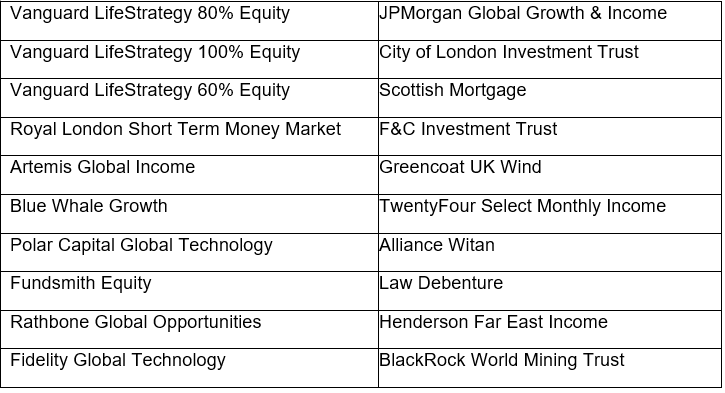
Source: AJ Bell
It’s noteworthy, said Coatsworth, that a money market fund (Royal London Short Term Money Market) appears high up the list of active fund preferences for DIY investors.
This fund category aims to deliver a return just above cash, “suggesting some caution among investors or a preference to blend some lower-risk investments with higher-risk ones in a portfolio”.
Fundsmith Equity managed to keep a space in the top 10 most popular active funds despite ongoing underperformance, while Artemis Global Income caught investors’ attention in a year when some people’s appetite for US exposure started to wane.
“The Artemis Global Income fund has much lower exposure to the US than the broader global stock market, and that was precisely what many individuals sought for their portfolios,” said Coatsworth, who hoped the results would be a wake-up call for the industry.
“Active managers hoping to keep investors on board and attract new ones are going to have to work their magic in 2026, otherwise the big migration to passive will gather pace,” he concluded.
Jupiter CEO Matthew Beesley says yes, but Premier Miton’s Gervais Williams suggests not.
Getting people investing in the UK market is a key concern for the government, as highlighted by chancellor Rachel Reeves’ policies.
While changes in her Budget, such as reducing the cash ISA allowance from April 2026 to £12,000 for under-65-year-olds while maintaining the stocks and shares ISA limit at £20,000, are designed to get more people putting money into the market, not all believe this government has done enough.
Gervais Williams, chair of equities at Premier Miton, said it was critical the UK has a strong stock market, as “investing locally means you generate local companies and they generate local work employment”.
As such, “when the local equity market works well, it delivers not just for investors, but actually for those who aren’t savers,” as it builds a healthier economy.
Yet markets have been shrinking globally, with fewer companies listing on stock exchanges – particularly here in the UK.
He suggested the government has been too focused on providing capital for private businesses through its Mansion House Compact initiative, which encourages large pension houses to increase investments into unlisted equities in an effort to deliver long-term value for savers.
“They just haven't worked out that, actually, to get the clearance in the private companies, you need quoted markets to be alive and there's been a real backlog, not just in the UK, but globally, where the number of listed companies has come down rather than gone up. And so this is a major issue,” said Williams.
A thriving public market encourages more businesses to list, giving them capital to invest and boosting productivity. This would allow these firms to “actually pay wages above inflation” and take some of the pressure off the government to intervene on things like gas bills. UK businesses also pay tax in this country, which means they add to the government’s coffers.
However, he did acknowledge there was a drive for a more thriving market and predicted “forthcoming governments” will look to push the agenda much further.
“We'll get lots of national politicians [focusing on] UK savings, UK jobs and bringing our capital back. I think that’s going to be a major trend,” he concluded.
Matthew Beesley, chief executive of Jupiter Asset Management, disagreed with Williams, noting the government has “done a lot” to improve the state of the UK market and drive more investment to domestic companies, which is attracting attention already from overseas investors.
“We have seen a sea shift on this as a subject, with a raft of changes and initiatives,” he said.
He noted that “the demise of the UK market has been a multi-year, multi-decade issue”, so it would be “unrealistic to see it fixed overnight”, but highlighted some key policies that could pay off in the future.
“A few months ago they [stated that] they're going to change the approach towards financial literacy in the classroom. It's a fundamental building block that's been woefully missing from this country, but that's going to have a payoff probably over the next 20 years, maybe even longer,” Beesley said.
“We're not to get excited about that today, but this is a great foundational reform that’s going to make a difference over time.”
Another more immediate policy is easing the regulatory burden by the Financial Conduct Authority (FCA), which he described as having now become “a lot more balanced”.
“Being a listed company and running an asset management firm that is regulated by the FCA is different today than it was many years ago. The slew of regulatory pressures we've all faced has somewhat abated. There's a pragmatism now about the regulator. That's got to be a good thing,” he said.
All this is paying off already, he argued.
“As a UK-listed asset management [firm] with a big UK equities business, we've got lots of clients coming to us today from outside of the UK, engaging with us and talking about UK equities because they see some of these points,” the Jupiter CEO said.
“Having been absent for the past 10, 15, or 20 years, which is the right thing to have done, they're now wondering whether that's something to address or redress now.”
And for investors, now is a good time to access the UK, as they are being “paid to wait” in the form of a “pretty healthy yield”, which is derived from lower starting valuations, bringing potential capital upside in the future.
Beesley added the investment landscape is “all about relativity” and at present, the UK is “relatively cheap versus lots of other markets”.
Six UK-focused strategies have a high correlation to the US market.
The UK market is praised for its dividend-paying champions, while the US is known for its high-growth technology companies. Investors know that and allocate money to one or the other expecting different patterns of returns, but this hasn’t been the case for some UK strategies, FE Analytics data has shown.
Trustnet looked at the five-year correlation between IA UK All Companies funds and the S&P 500, and while the average number across the sector was 0.59, there were seven outlier funds, which displayed high levels of correlation of 0.7 or above.
This means their performance moves reasonably in line with the powerhouse US index. Investors aiming at greater diversification should therefore pay attention when investing in these strategies, in particular if they are already investing in the US via an S&P 500 tracker.
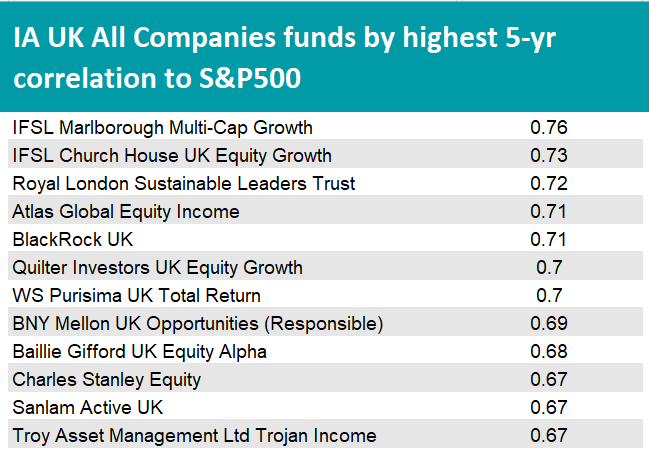
Source: FE Analytics
The IFSL Marlborough Multi-Cap Growth fund topped the table with a correlation of 0.76, the highest in the sector. This £130m portfolio is run by FE fundinfo Alpha Manager Richard Hallett and concentrated in about 30 names.
Its top 10 holdings weigh heavily into UK financials – such as JTC (6.1%), Close Brothers (5.4%) and St James’s Place(4.5%) – and industrial companies – including Melrose Industries (4.8%) and Ashtead Group (3.6%).
The strategy received a FundCalibre Elite rating for its “fantastic track record when it comes to stock-picking skill”, with analysts stressing that this fund invests more in larger companies than most other Marlborough funds as “a deliberate move to pick up on the growth opportunities across the whole market spectrum”.
“The manager’s macroeconomic overlay helps to add context,” they added.
In second position, the £89m IFSL Church House UK Equity Growth fund had a 0.73 correlation.
It invests 62.5% of its assets under management in FTSE 100 companies, 15% approximately in UK small-and mid-caps, and 18.8% in overseas companies, with the latter figure being led by a 4.1% weighting to Microsoft.
Concluding the top three was the £2.6bn Royal London Sustainable Leaders Trust (0.72).
FE Investments analysts said its investment style “brings something different to UK equity funds”, as it combines sustainable principles with “in-depth company financial analysis” and makes “a very good candidate” for investors who want exposure to companies that are making a positive impact for society or operating in a sustainable manner.
“[Alpha Manager] Mike Fox is a very experienced manager and his track record highlights the benefits of his style,” they said. “Despite several periods of outperformance of cyclical sectors, the fund beat its peers and the wider market over the long term.”
Earlier this year, the fund appeared on Trustnet as one of the most consistent UK funds of the decade.
The £322m BlackRock UK fund and the Quilter Investors UK Equity Growth fund (also managed by BlackRock) made the list with a 0.71 and 0.7 correlation figure, respectively. The former has a large-cap focus, while the latter is benchmarked against the MSCI UK All Cap index.
The small WS Purisima UK Total Return also made the list.
Growth funds were a clear theme in the study. While many bemoan the lack of growth available in the UK, those funds that specialise in the investment style were highly correlated to the US market. These included BNY Mellon UK Opportunities (Responsible) (0.69), Baillie Gifford UK Equity Alpha (0.68) and Sanlam Active UK (0.67). However, the lower-risk and income-focused Troy Trojan Income also had a higher correlation of 0.67.
Performance of funds against indices and sector over 5yrs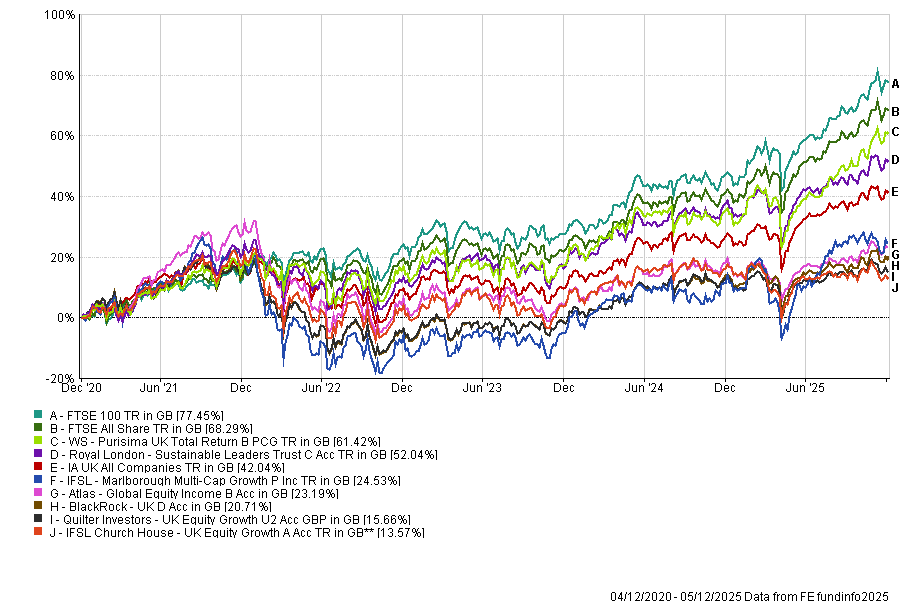
Source: FE Analytics
The strategies at the opposite end of the table tended to be more heavily skewed towards value opportunities, although this wasn’t a rule.
TM Oberon UK Core and Thesis Stonehage Fleming Opportunities had the lowest S&P 500 correlation, both at 0.31.
The former is a small (£20m) portfolio, concentrated in sectors such as healthcare, tobacco, insurers and oil and gas; the latter (£79m) focuses on smaller companies and recovery names.
The popular Invesco UK Opportunities (UK) (1.8bn) concluded the bottom three, with a correlation of 0.32. It is run by Martin Walker with a bottom-up, high-conviction and valuation-focussed approach.
RSMR strategies favour it for being a “consistent large-cap strategy”, having produced “strong” and “consistent” risk-adjusted returns.
They said: “Bottom-up fundamental proprietary research leads to a high conviction fund that should outperform the peer group average over a full cycle.”
Other lowly correlated names included Redwheel UK Climate Engagement (0.35), Premier Miton UK Focus (0.36) and JOHCM UK Growth (0.37).
Previously in this series: the funds most and least tied to the S&P 500 in the IA Global Equity Income, IA Mixed Assets and IA Flexible Investment sectors, and the unexpected fund sectors with high and low correlations to the S&P 500.

The information contained within this website is provided by Allfunds Digital, S.L.U. acting through its business division Digital Look Ltd unless otherwise stated. The information is not intended to be advice or a recommendation to buy, sell or hold any of the shares, companies or investment vehicles mentioned, nor is it information meant to be a research recommendation. This is a solution powered by Allfunds Digital, S.L.U. acting through its business division Digital Look Ltd incorporating their prices, data news, charts, fundamentals and investor tools on this site. Terms and conditions apply. Prices and trades are provided by Allfunds Digital, S.L.U. acting through its business division Digital Look Ltd and are delayed by at least 15 minutes.
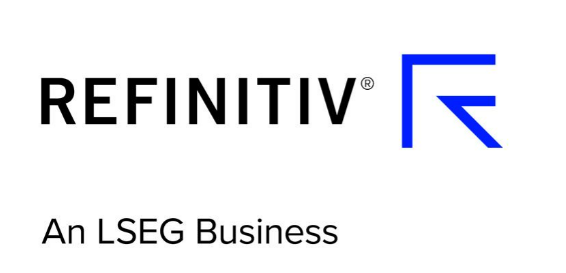
© 2025 Refinitiv, an LSEG business. All rights reserved.
 Please wait...
Please wait...
Barclays Investment Solutions Limited provides wealth and investment products and services (including the Smart Investor investment services) and is authorised and regulated by the Financial Conduct Authority and is a member of the London Stock Exchange and NEX. Registered in England. Registered No. 2752982. Registered Office: 1 Churchill Place, London E14 5HP.
Barclays Bank UK PLC provides banking services to its customers and is authorised by the Prudential Regulation Authority and regulated by the Financial Conduct Authority and the Prudential Regulation Authority (Financial Services Register No. 759676). Registered in England. Registered No. 9740322. Registered Office: 1 Churchill Place, London E14 5HP.